| Abell 33 - The Diamond Ring Nebula The Diamond Ring Nebula is a very faint spherical planetary nebula in the constellation Hydra. It gets its bluish color from doubly ionized oxygen. The star in the lower-right corner of the nebula is not associated with the nebula, but actually considerably closer to us. Since the nebula is so faint, one can only see it with a timed exposure. It lies about 2700 light-years away from us. Image processed by Ron Yelton, original data from Telescope Live |
Gamma Cygni Nebula The image of this nebula is just part of the nebulosity that surrounds the star Navi, in the constellation Cassiopeia. The hot stars embedded in the nebulosity excite (heat) the surrounding gasses enough that the gasses begin to glow. That makes most of the nebula an emission nebula. This one is about 1500 light-years away. Image processed by Ron Yelton, original data from Telescope Live |
NGC 1923 This particular object is a combination of an star cluster and nebula locate\d in the constellation Dorado. Unfortunately, I couldn't find any more information on this object. Image processed by Ron Yelton, original data from Telescope Live |
|
Location: El Sauce
Observatory, Chile
Date: January 2025 Mount: Mathis MI-1000/1250 Telescope: Planewave CDK24 (CHI-1) Camera: QHY600m @-25c Exposure: 18 x 5 min for LRGB. Total: 1 hrs 30 min |
Location: IC Astronomy Observatory, Spain
Date: June 2024 Mount: Paramount MX+ Telescope: Takahashi FSQ-106ED (SPA-1) Camera: QHY600m CMOS @ -25c Exposure: SHO 36 x5 min Total: 3 hrs |
Location: El Sauce
Observatory, Chile
Date: November 2024 Mount: Mathis MI-1000/1250 Telescope: Planewave CDK24 (CHI-1) Camera: QHY600m @-25c Exposure: 81 x 5 min for RGB. Total: 6 hrs 45 min |
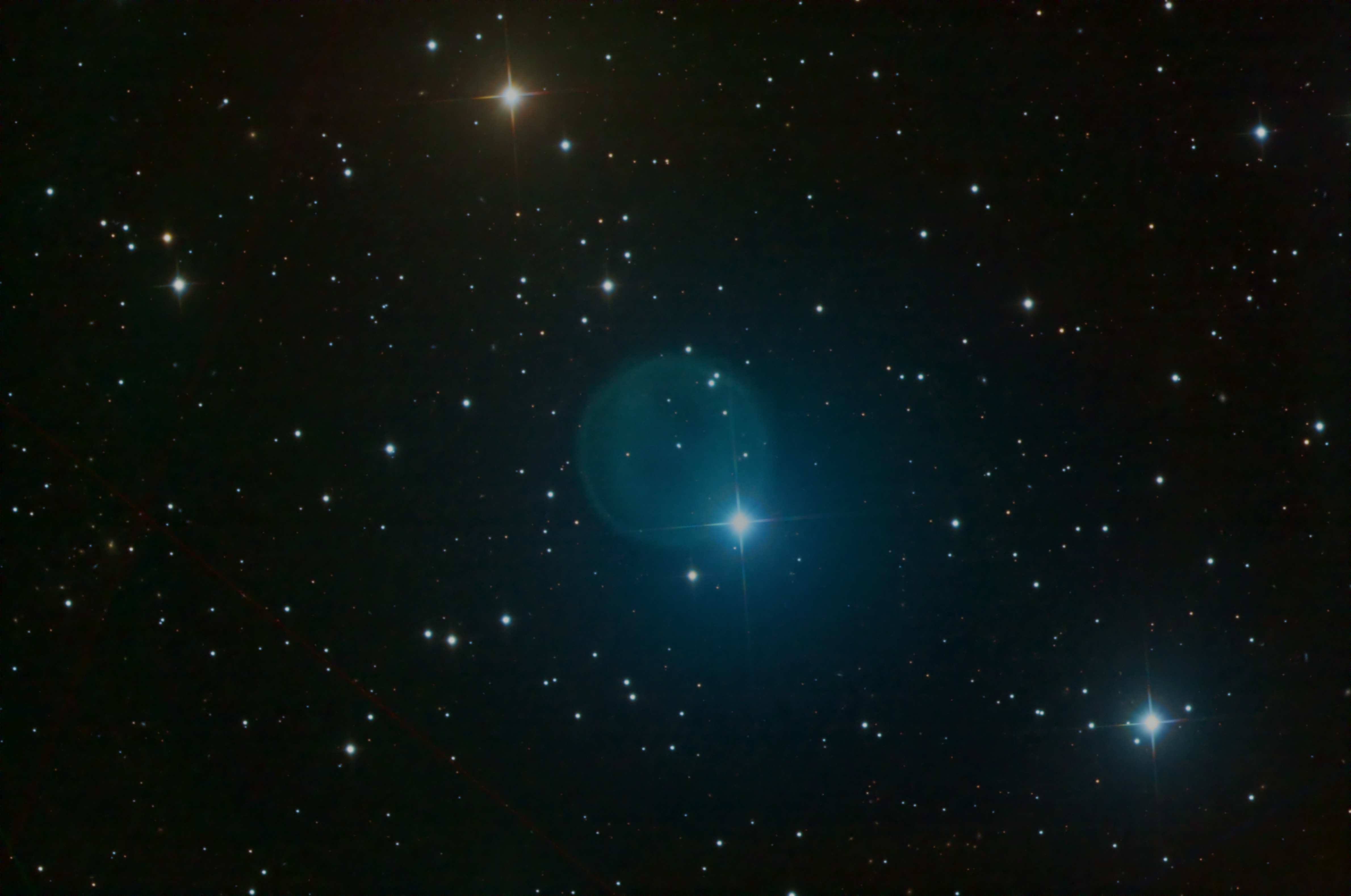 |
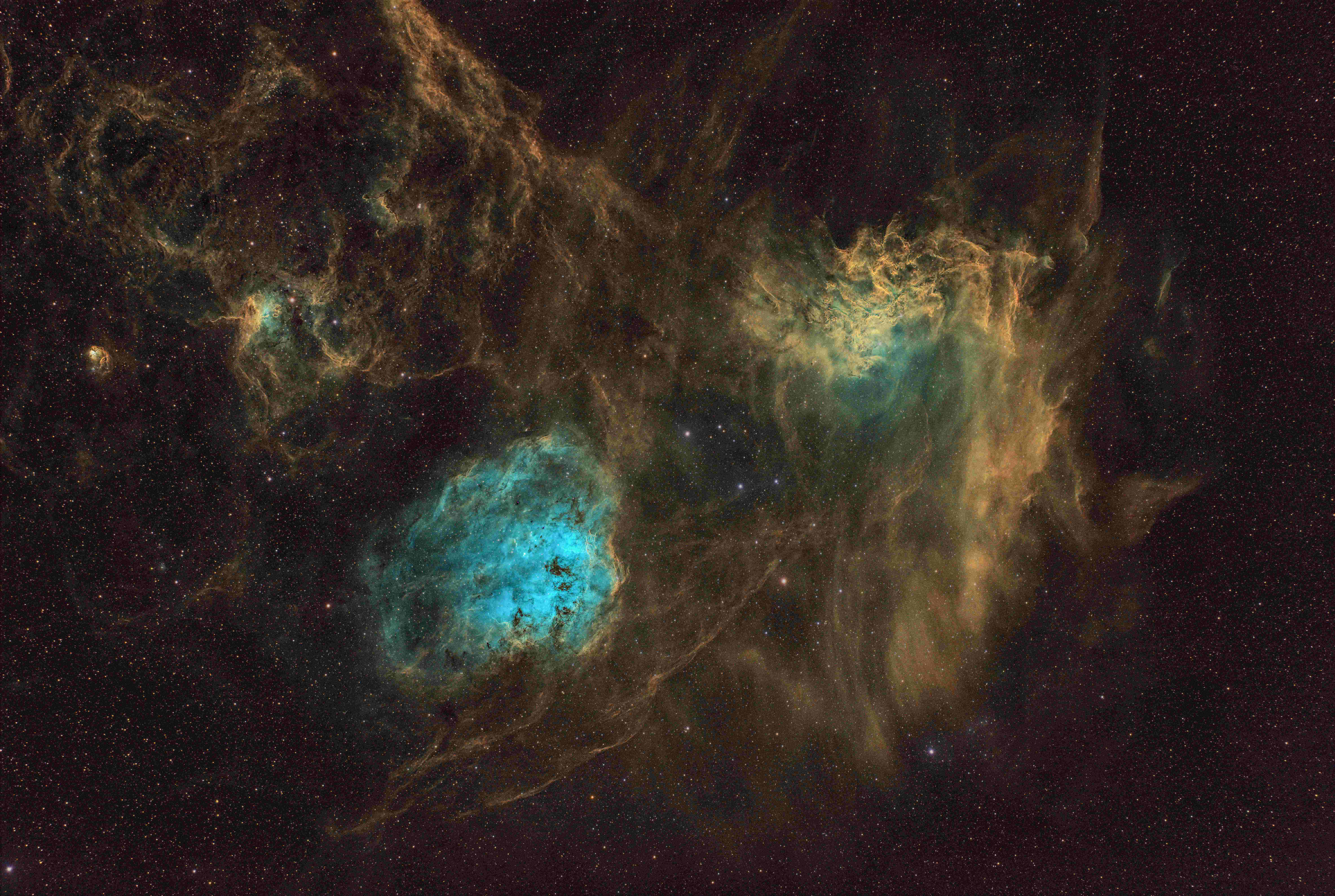 |
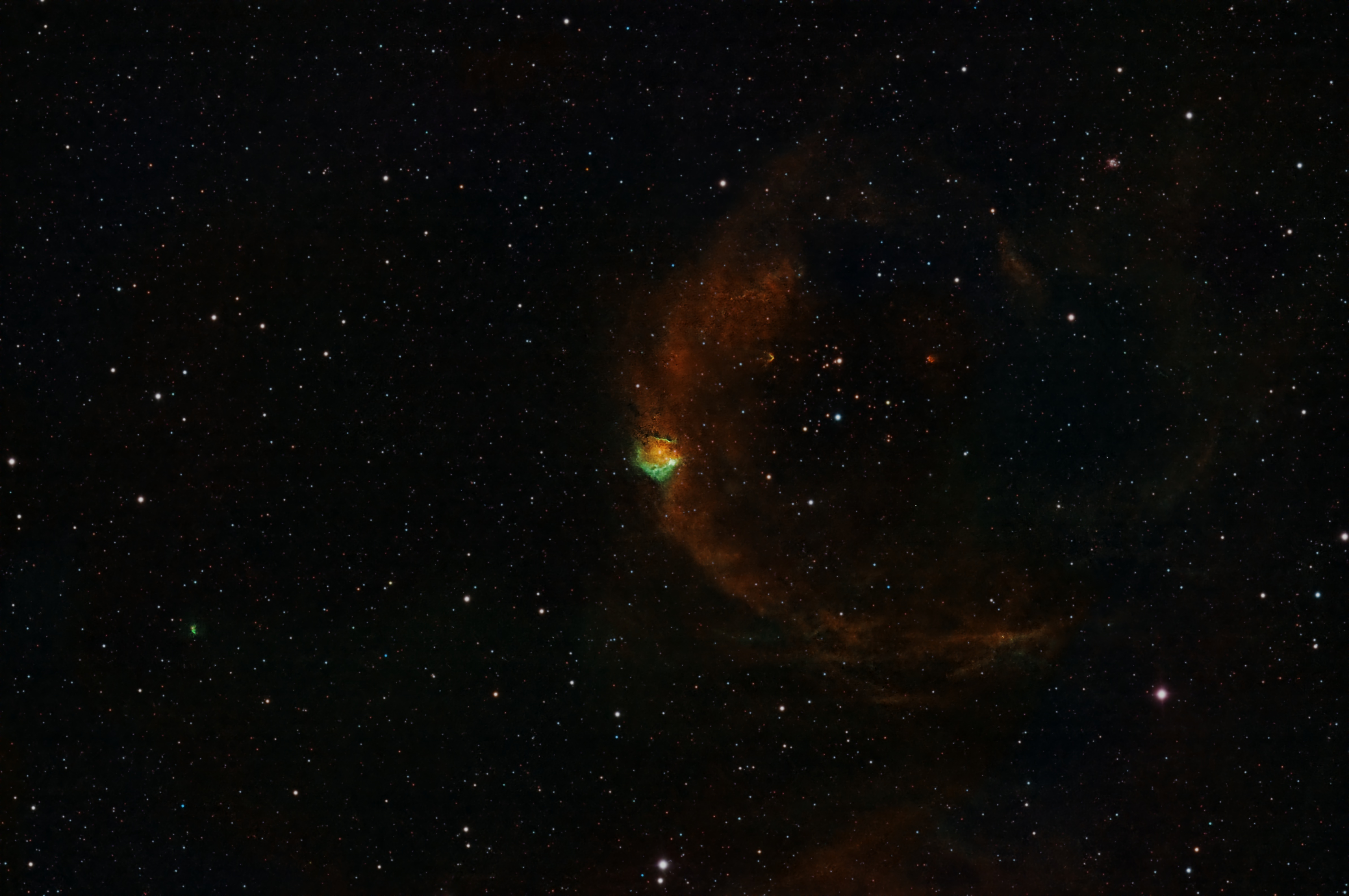 |
| RCW 104 This nebula is located in the southern constellation of Norma (the Carpenter's Square). It's known as a ring type nebula that surrounds a wolf-reyet star that emits large amounts of radiation that shapes the surrounding gas clouds. in this image, the blue represents ionized hydrogen (HII). Image processed by Ron Yelton, original data from Telescope Live |
IC 405 - The
Flaming Star Nebula Both an emission and reflection nebula, this nebula is only 1500 light-years away in the constellation Auriga (the Charioteer). Its diameter is about 5 light-years. The central star is thought to have originated in the area of Orion's Belt and then wandered off to Auriga. Image processed by Ron Yelton, original data from Telescope Live |
IC 405 - The
Flaming Star Nebula This one is the same image of the Flaming Star Nebula, just without the stars. Removing the stars sometimes gives the image a completely different feel. Image processed by Ron Yelton, original data from Telescope Live |
|
Location: El
Sauce Observatory, Chile
Date: March 2025 Mount: Mathis MI-1000/1250 Telescope: Planewave CDK24 (CHI-1) Camera:QHY600m @-25c (CMOS) Exposure: 54 x 5 min for OHS. Total: 4 hrs 30 min |
Location: IC Astronomy Observatory, Spain
Date: July 2023 Mount: Paramount MX+ Telescope: Takahashi FSQ-106ED (SPA-1) Camera: QHY600m CMOS @ -25c Exposure: 31 x 5 min for OHS Total: 2 hrs 35 min |
Location: IC Astronomy Observatory, Spain
Date: July 2023 Mount: Paramount MX+ Telescope: Takahashi FSQ-106ED (SPA-1) Camera: QHY600m CMOS @ -25c Exposure: 31 x 5 min for OHS Total: 2 hrs 35 min |
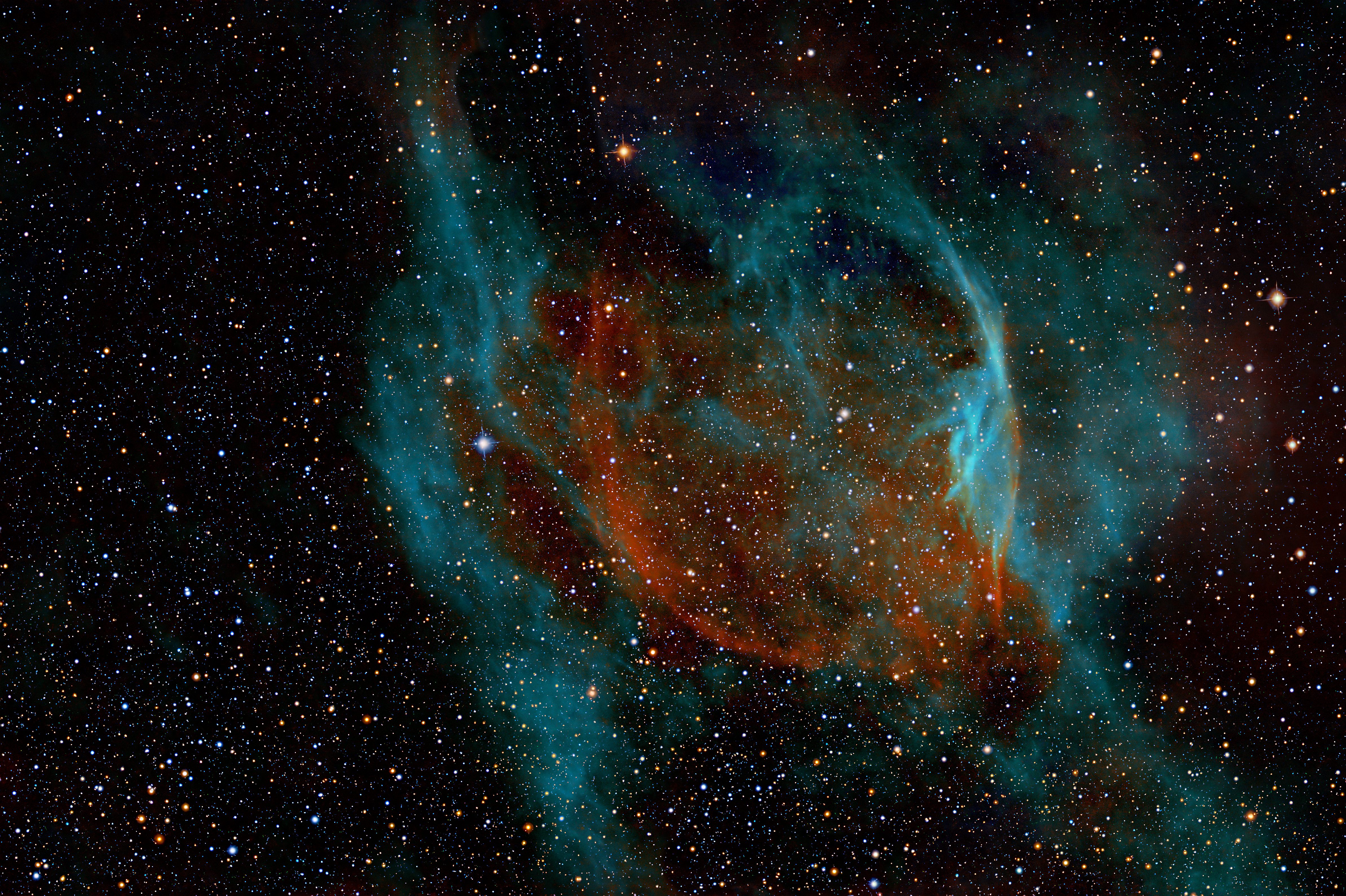 |
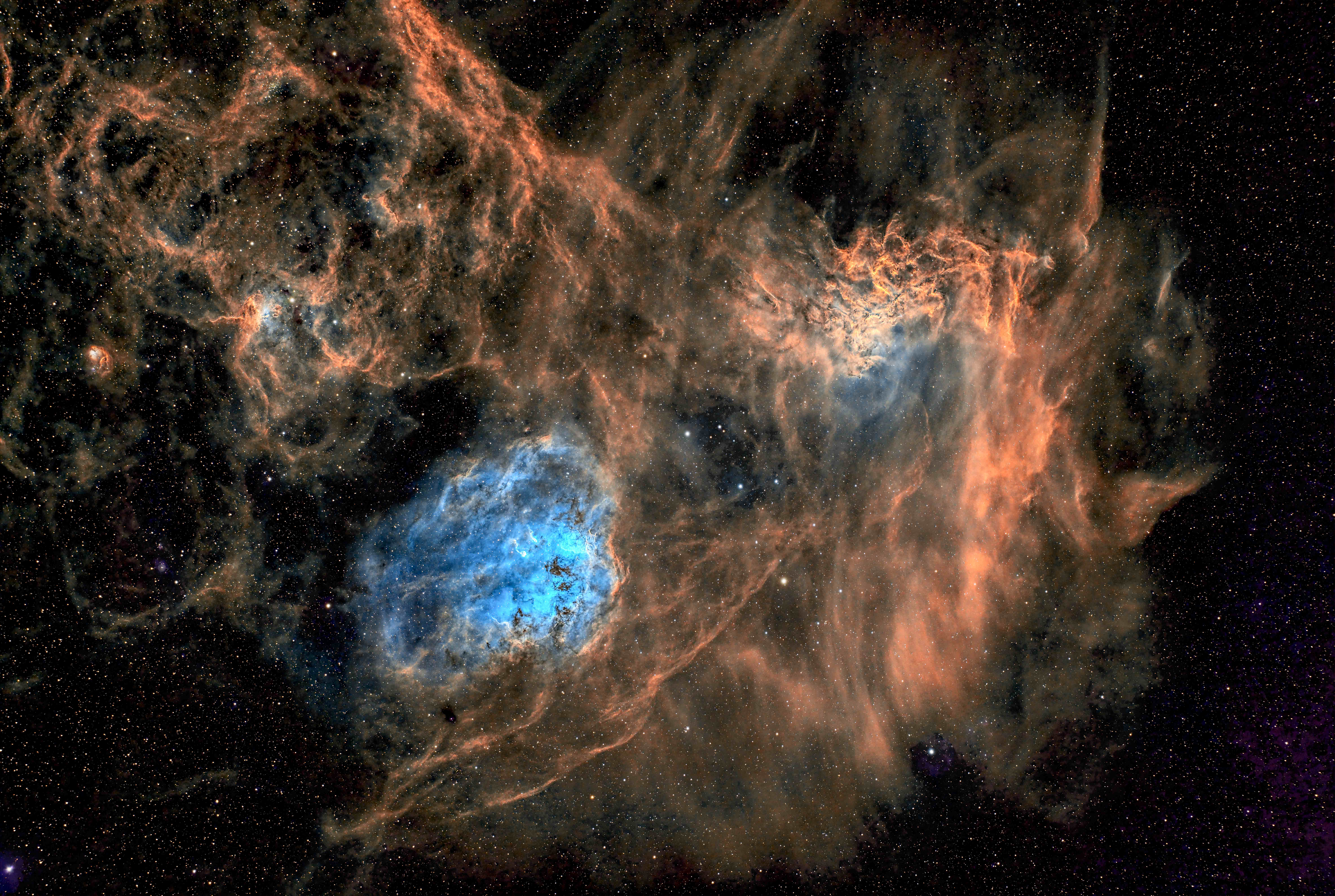 |
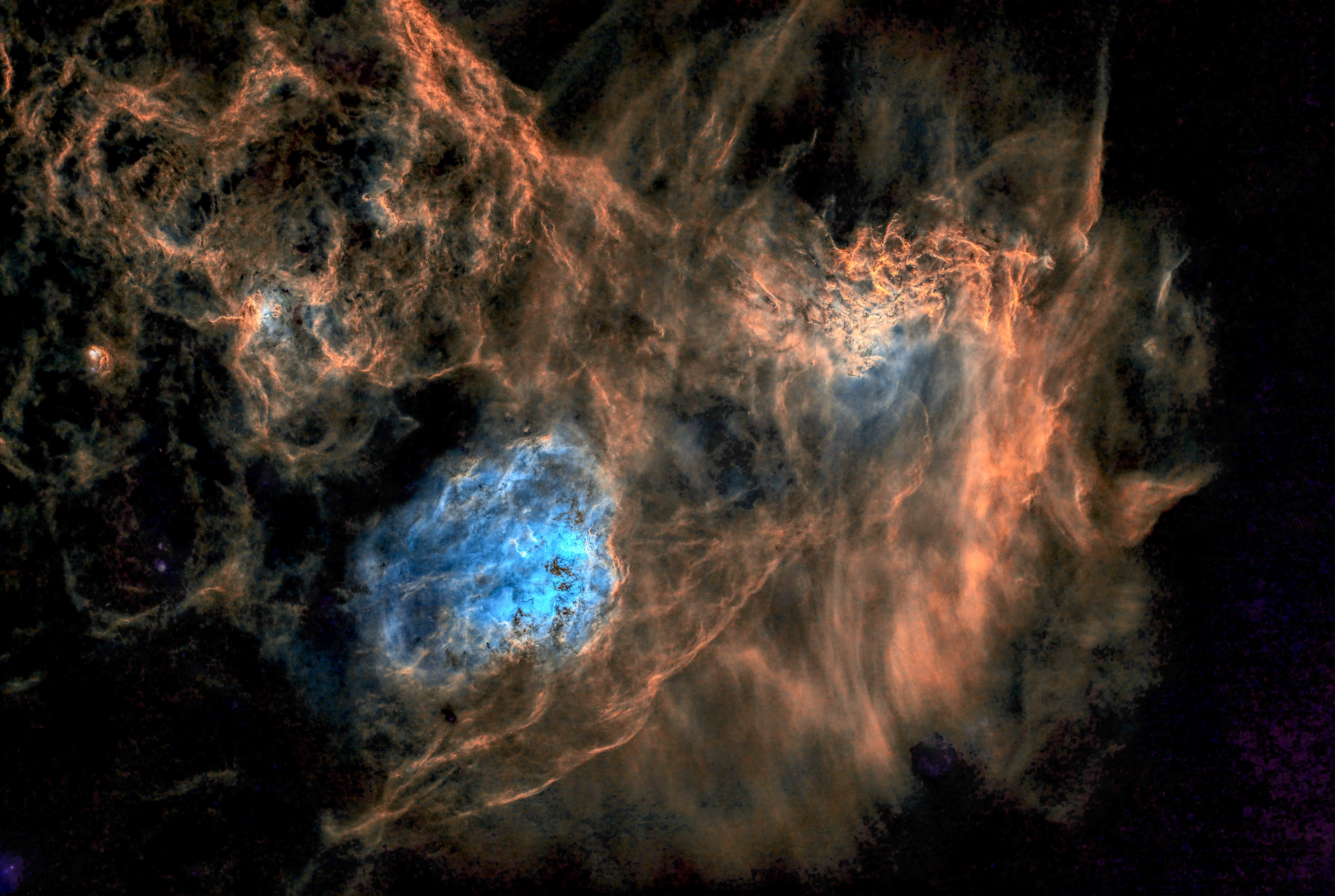 |
| RCW 16 - Skull and Crossbones
Nebula RCW 16 is an emission nebula located in the constellation Puppis. It is also known as the Skull and Crossbones Nebula or the Mandrill Nebula. It is roughly 15,000 light-years away from us and has a diameter of about 200 light-years. It is also an active star-making factory. Image processed by Ron Yelton, original data from Telescope Live |
NGC 3324 (IC 2599) NGC 3324 is actually an open star cluster that is mistakenly associated with IC 2599 which is an emission nebula. Together they have been nicknamed The Gabriela Mistral Nebula. The entire area is an active star-making region. Its age has been estimated at about 12 million years old. It is 9,100 light-years away from Earth. Post-processed in the OHS palette. Image processed by Ron Yelton, original data from Telescope Live |
Messier
42 - The Great Orion Nebula This famous nebula is an emission nebula and an active star-making region in the constellation Orion (The Hunter). It is so bright that it is usually mistaken as the middle "star" in Orion's sword. Inside the bright spot in the center are a number of stars that are referred to as the Trapezium. With a good medium sized telescope, at least 4 stars can be seen there. All of the stars in this nebula are relatively young, very hot stars, whose radiant energy heats the surrounding gasses to the point that they glow. it is one of the most observed and photographed deep sky objects. 1344 ly away and 25 ly across. Just above the nebula is another nebula by the name of The Running Man Nebula. Image processed by Ron Yelton, original data from Telescope Live |
| Location:
Heaven's Mirror Observatory,
Australia
Date: March 2025 Mount: Paramount MX+ Telescope: FSQ-106ED (AUS-2) Camera: QHY600m @ -25c Exposure: 80 x 5 min each for OHS Total:6h hrs 40 min |
Location: El
Sauce Observatory, Chile
Date: April 2025 Mount: Mathis MI-1000/1250 Telescope: Planewave CDK24 (CHI-1) Camera:QHY600m @-25c (CMOS) Exposure: 32 x 5 min for OHS. Total: 2 hrs 40 min |
Location:
Heaven's Mirror Observatory,
Australia
Date: May 2024 Mount: Paramount MX+ Telescope: FSQ-106ED (AUS-2) Camera: QHY600m @ -25c Exposure: 131 x 5 min each for LRGB Total:10h hrs 55 min |
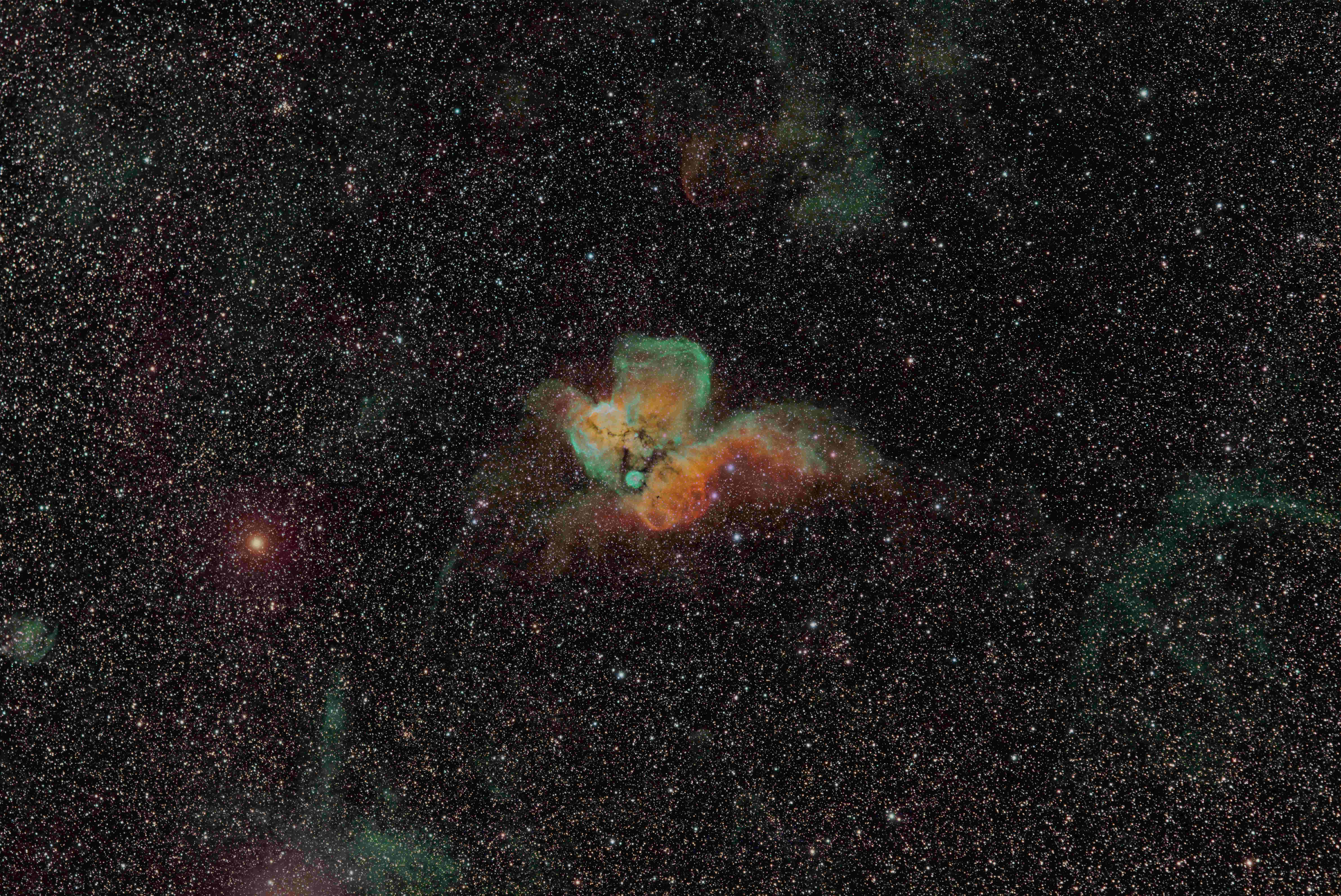 |
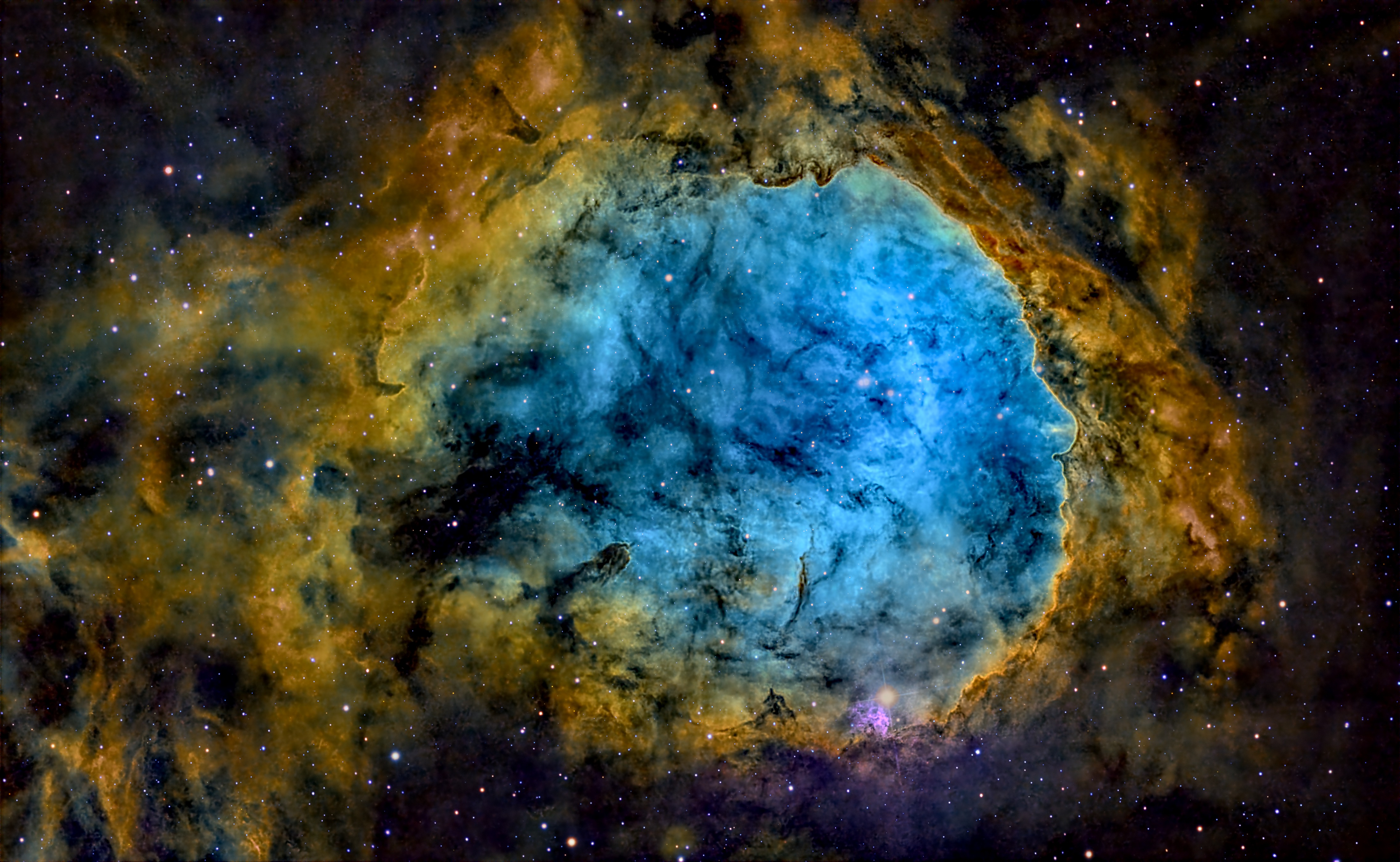 |
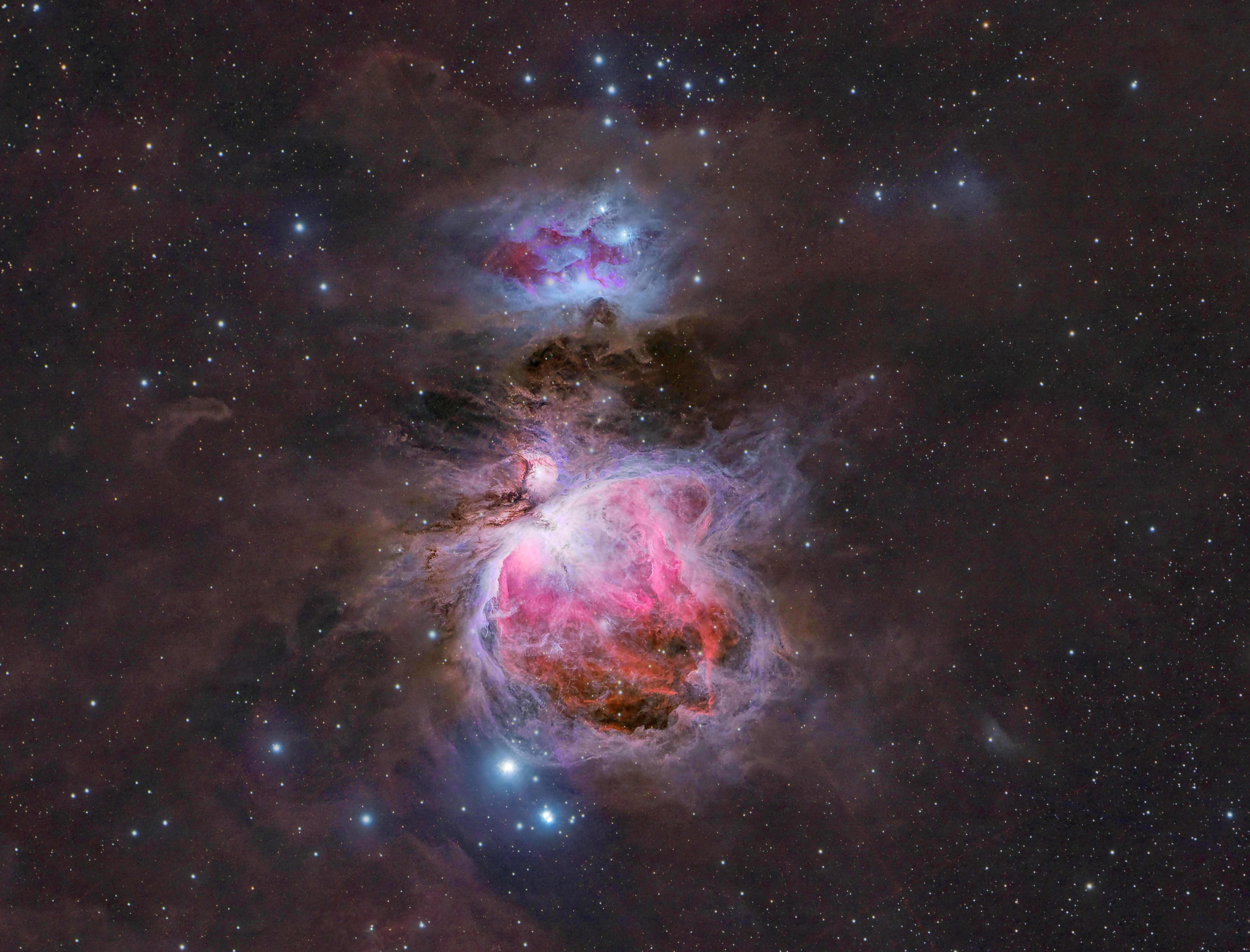 |
| Messier 42 - The Great Orion
Nebula One of the most popular observing and imaging objects in our nighttime sky is the Orion Nebula. Please see the info in the preceding panel. Usually, this object is imaged using visible light filters. This version was done using narrowband filters in the OHS scheme (Ha, OIII and SII). Image processed by Ron Yelton, original data from Telescope Live |
IC-359 I was unable to find any information on this nebula. This data set from Telescope Live is labeled as IC 359, but the only thing I could find online is a galaxy designated as IC 359. Anyway, this looks to me to be a field of dust. There is is some nebulosity around the three blue stars that appear to be not close enough to the dusty areas to make this a reflection nebula. Image processed by Ron Yelton, original data from Telescope Live |
IC 4628 - The Prawn Nebula This one is an emission nebula located in the constellation Scorpius. It sits about 6,000 light-years from Earth. Image processed by Ron Yelton, original data from Telescope Live |
|
Location:
Heaven's Mirror Observatory,
Australia
Date: August 2023 Mount: Paramount MX+ Telescope: FSQ-106ED (AUS-2) Camera: QHY600m @ -25c Exposure: 150 x 30 sec each for OHS Total:1h hrs 15 min |
Location: IC Astronomy
Observatory, Spain Date: December 2021 Mount: Paramount MX+ Telescope: Takahashi FSQ-106ED (SPA-1) (CCD) Camera: FLI PL16083 Exposure: 48 x 5 min for Ha, OIII and SII. Total: 8 hrs |
Location:
Heaven's Mirror Observatory,
Australia
Date: March 2024 Mount: Paramount MX+ Telescope: FSQ-106ED (AUS-2) Camera: QHY600m @ -25c Exposure: 63 x 5 min each for OHS Total: 5 hrs 15 min |
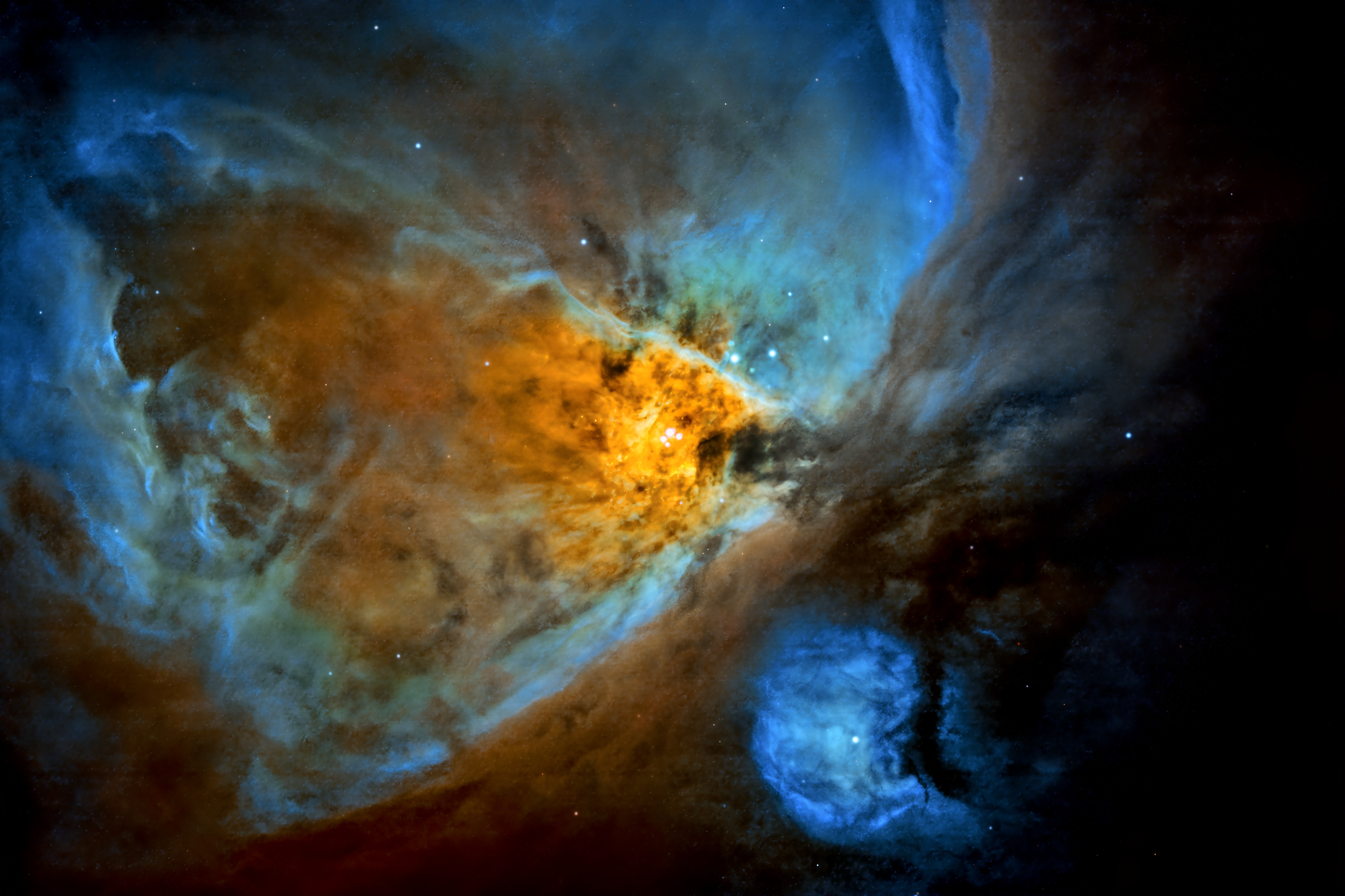 |
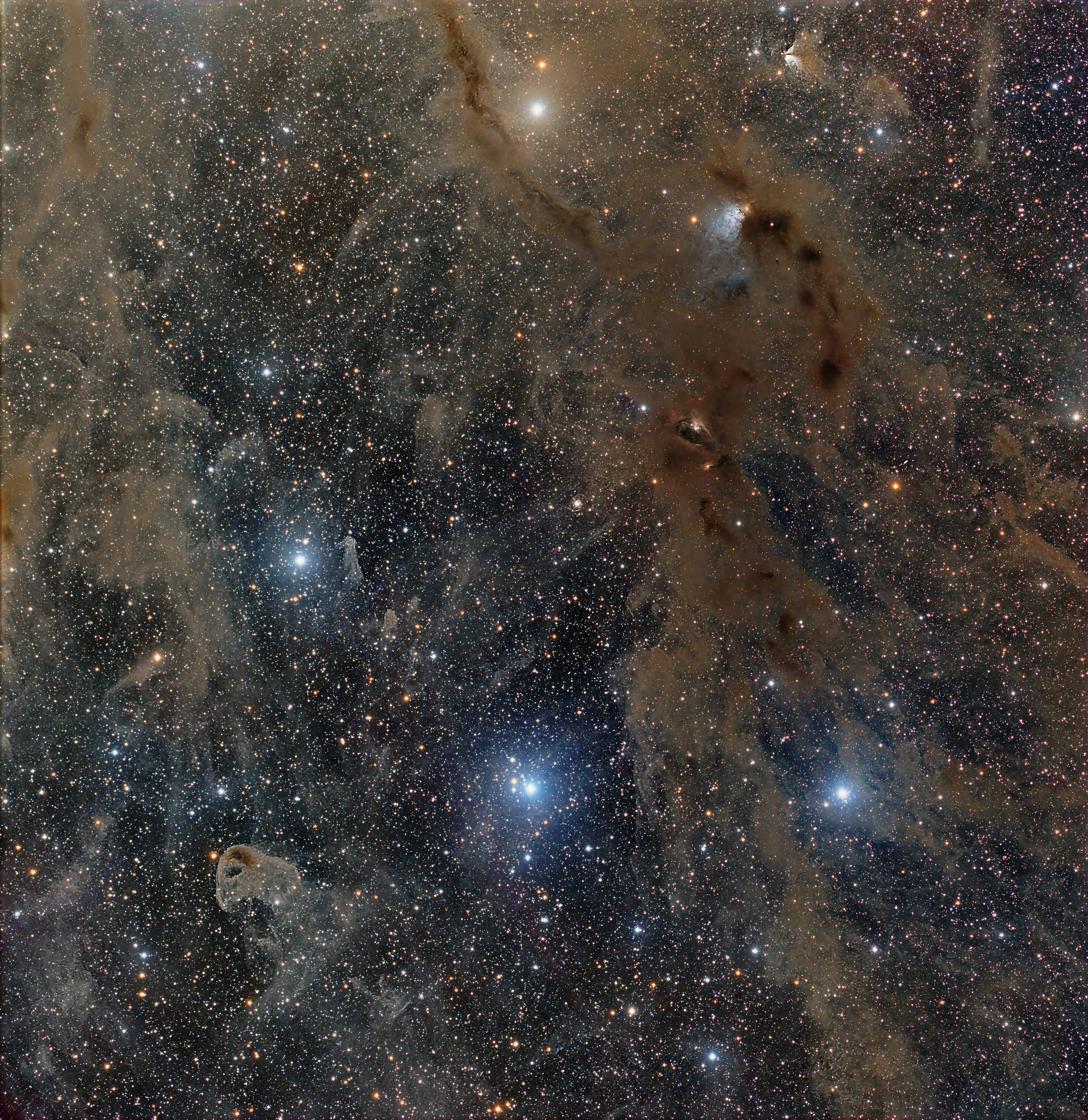 |
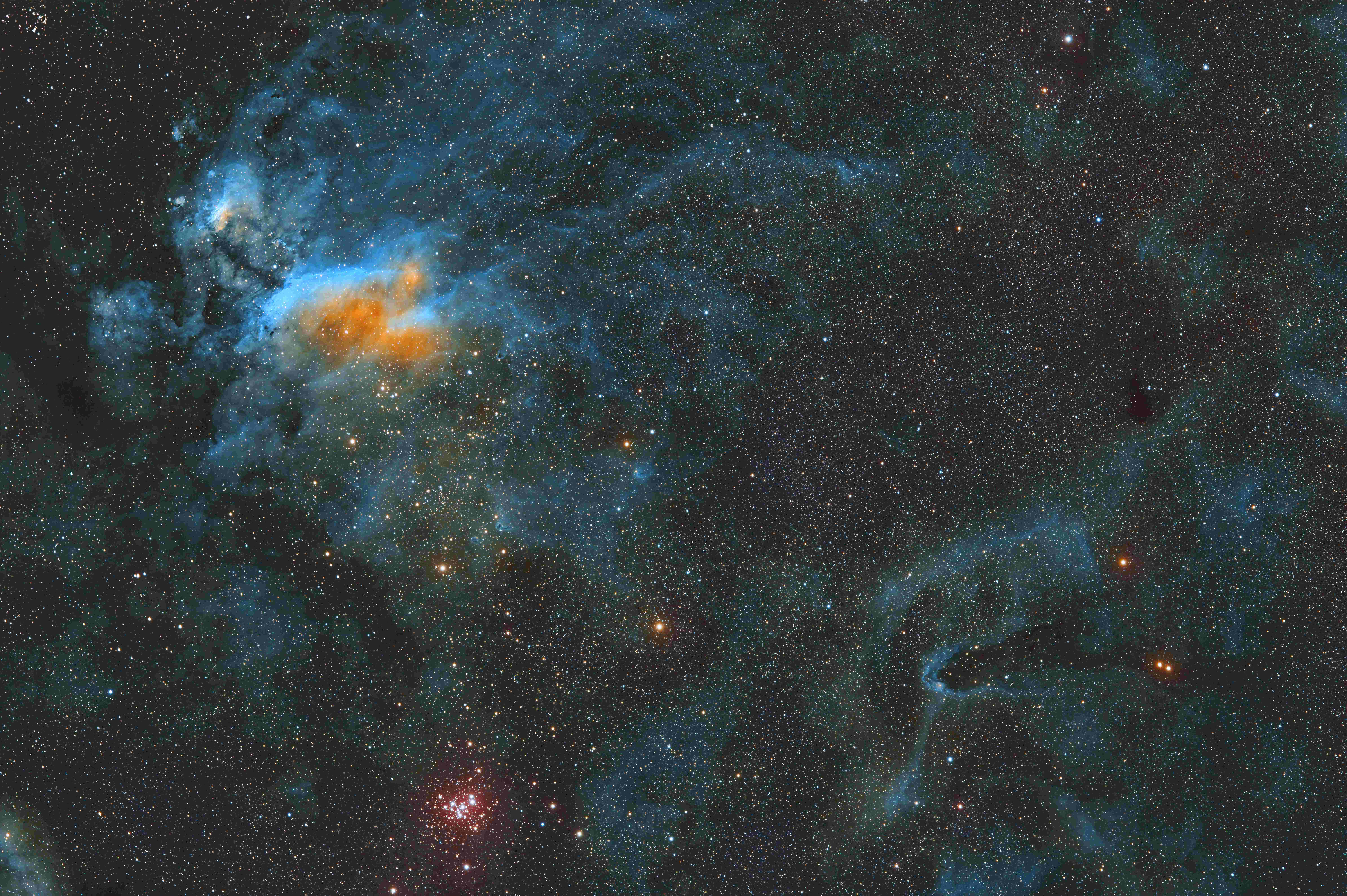 |
| IC 2944 This is another instance where I've processed an image twice in two different palettes. This one was done in SHO. Most of the image is taken up by the Running Chicken emission nebula, while IC 2944 is actually the open cluster up near the top of the image. In the lower part of the blue region there are a number of Bok globules (small black dots), which are active star making areas. It sits about 6,500 light-years away from us. Image processed by Ron Yelton, original data from Telescope Live |
IC 2944 This Here is the other version of IC 2944 to the left. This one was processed using the OHS palette. Image processed by Ron Yelton, original data from Telescope Live |
NGC 6888 -
The Crescent Nebula (HOO) This is a wide-field view of the Crescent Nebula and its surroundings. It is located in the constellation Cygnus (The Swan) and lies about 5000 light-years away from us. This one was post-processed in the HOO palette. That is, Hydrogen assigned to the red channel and Oxygen to both the Green and Blue channels, which makes for some interesting colors. There is a little red circle down at the bottom-left of the image. That is Sharpless-104 (Sh2-104), which is a small emission nebula. Image processed by Ron Yelton, original data from Telescope Live |
|
Location:
Heaven's Mirror Observatory,
Australia
Date: April 2025 Mount: Paramount MX+ Telescope: FSQ-106ED (AUS-2) Camera: QHY600m @ -25c Exposure: 91 x 5 min each for SHO Total: 7 hrs 35 min |
Location:
Heaven's Mirror Observatory,
Australia
Date: April 2025 Mount: Paramount MX+ Telescope: FSQ-106ED (AUS-2) Camera: QHY600m @ -25c Exposure: 91 x 5 min each for SHO Total: 7 hrs 35 min |
Location: IC Astronomy Observatory, Spain
Date: May 2023 Mount: Paramount MX+ Telescope: Takahashi FSQ-106ED (SPA-1) Camera: QHY600m CMOS @ -25c Exposure: 61 x 5 min for HOO Total: 5 hrs 5 min |
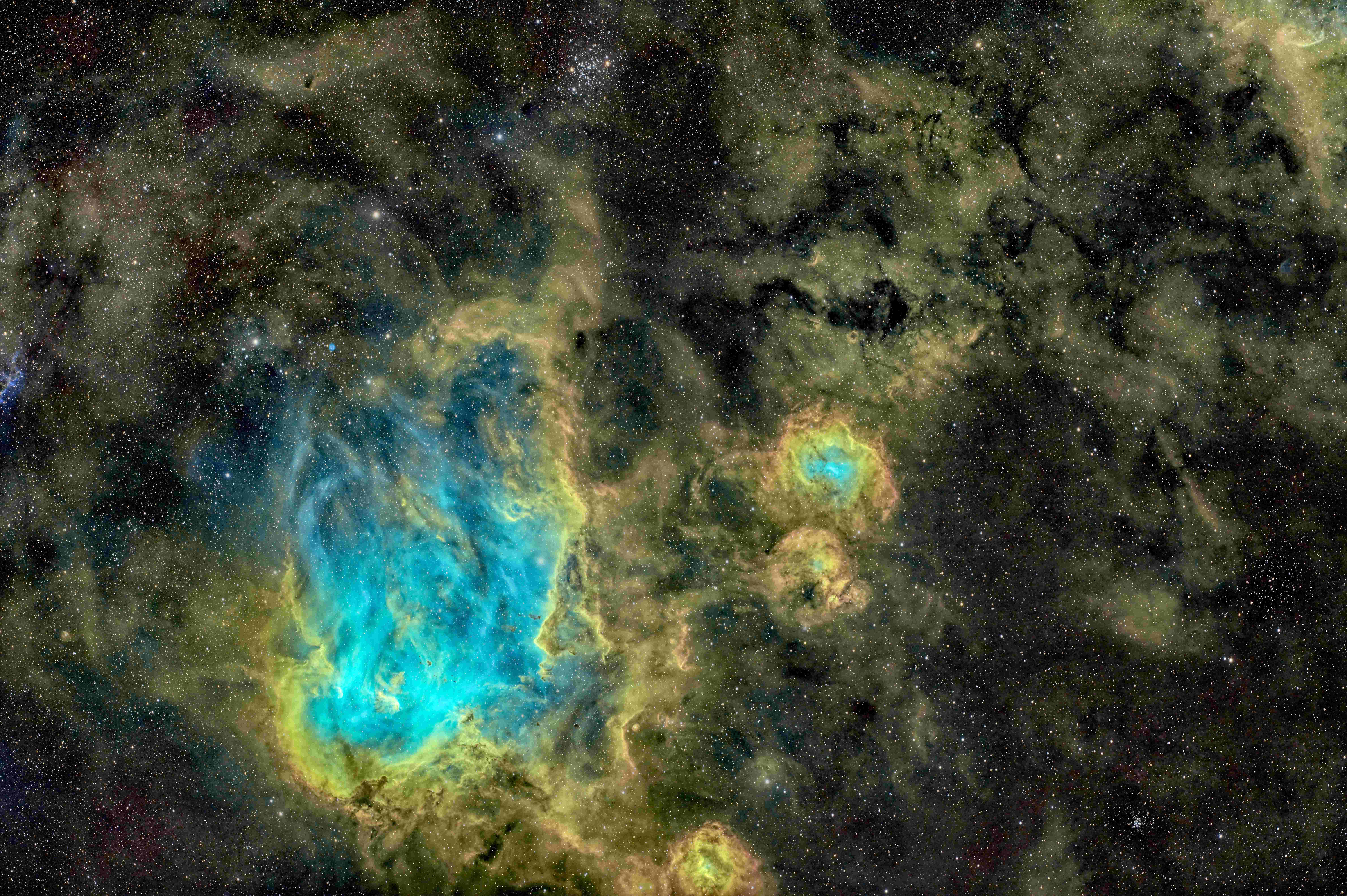 |
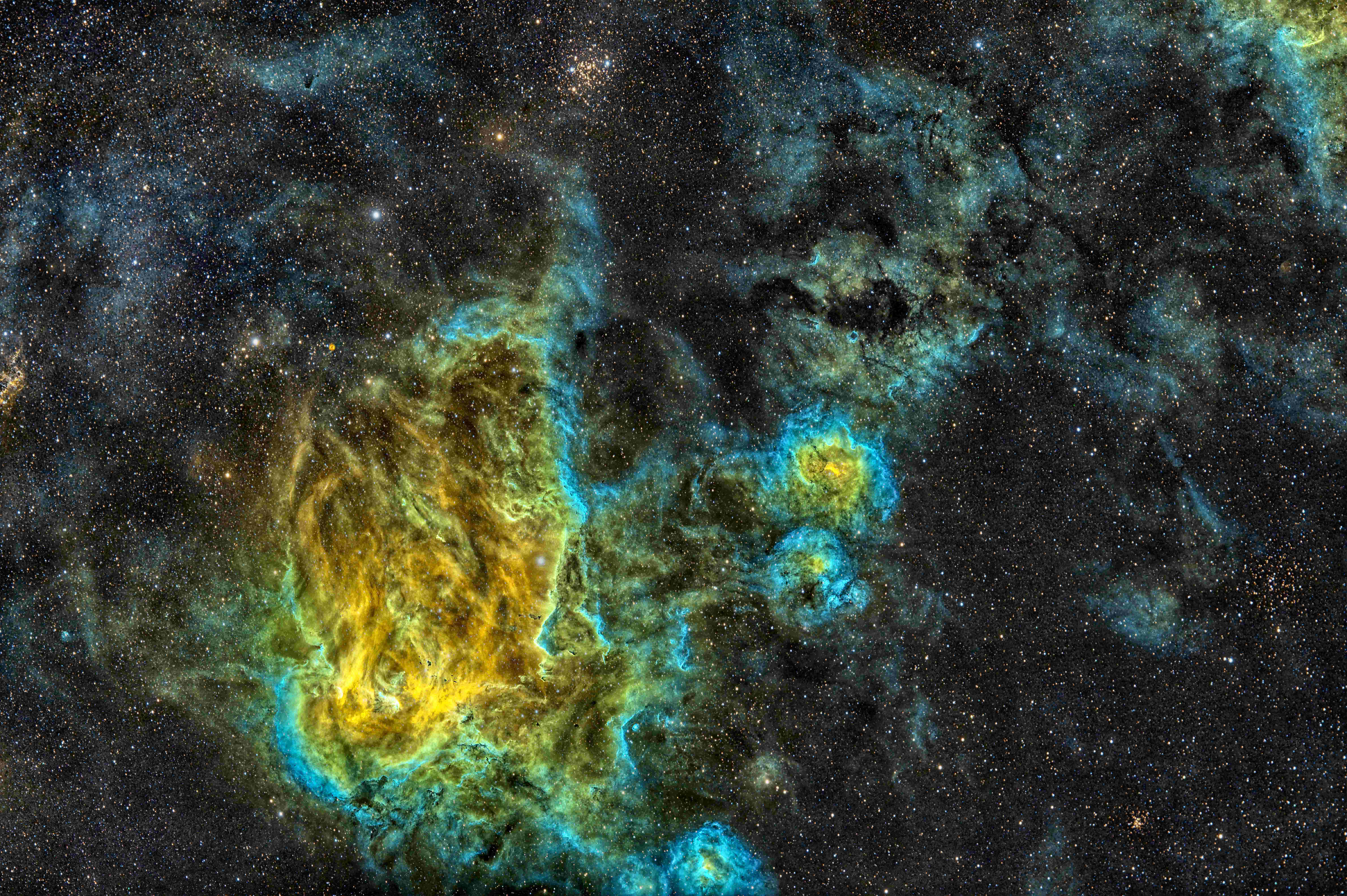 |
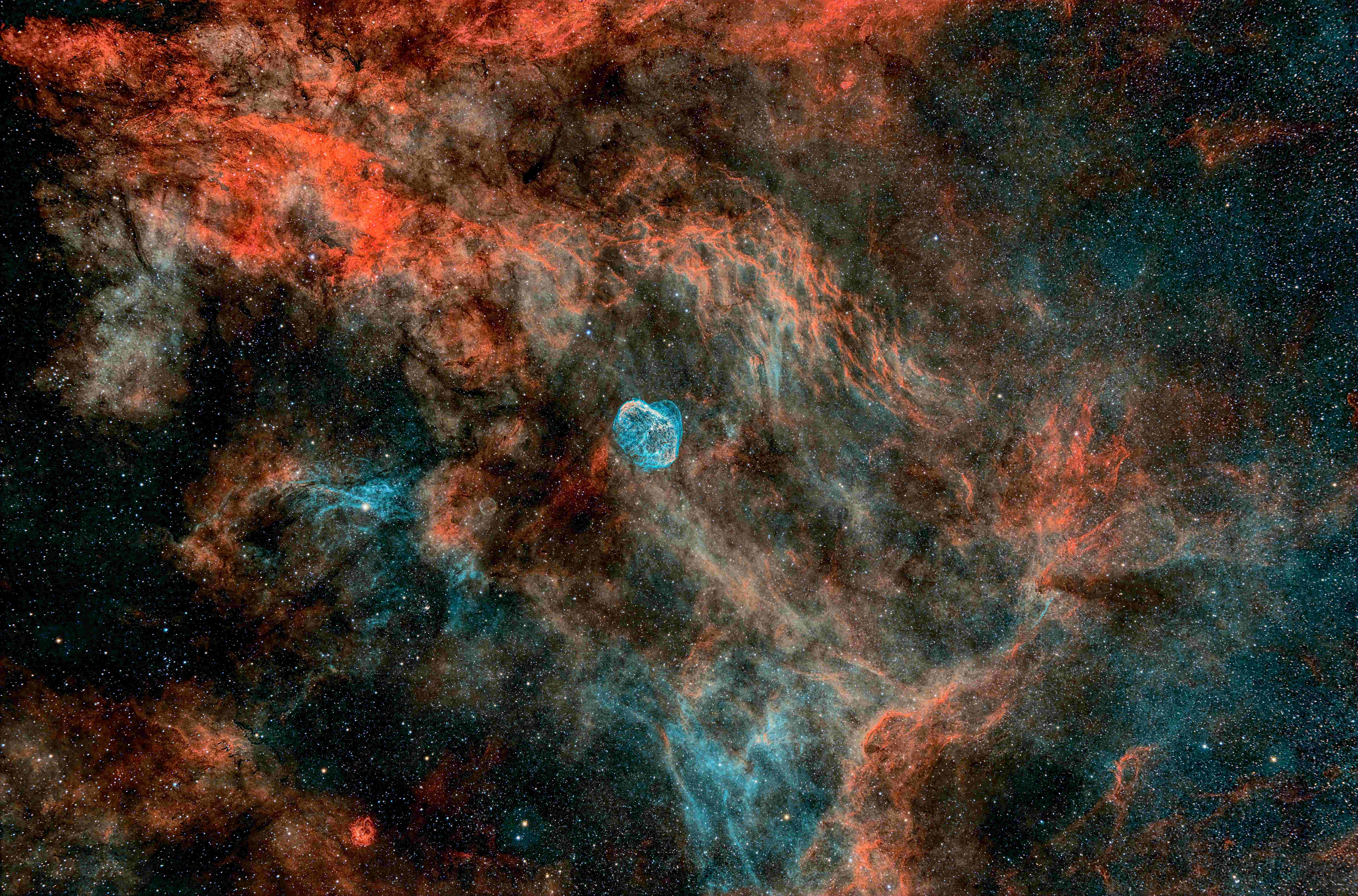 |
| NGC 6888 - The
Crescent Nebula (HOO) This a cropped version of the preceding image of NGC 6888. If you click on the the image you can see a blown-up version. Just to the Crescent's 8 o'clock position is another small nebula. This one is called the Soap Bubble Nebula. It is very faint and difficult to see except with a moderately large telescope and long exposure times.. It was discovered in 2007 by amateur astronomer Dave Jurasevich using an Astro-Physics 100 mm refractor telescope. This little nebula is a plnetary nebula. Image processed by Ron Yelton, original data from Telescope Live |
NGC 6888 - The
Crescent Nebula (OHS) Here we are continuing this series on the Crescent Nebula.With this one and the next, I've changed the color palette to OHS: red = oxygen, green = hydrogen and blue = sulphur. You can get some pretty interesting and whacky looking images, but with a palette change you can always see a completely new set of details in the image. Image processed by Ron Yelton, original data from Telescope Live |
NGC 6888 - The Crescent Nebula (OHS) A zoomed-in view of the image to the left. Image processed by Ron Yelton, original data from Telescope Live |
|
Location: IC Astronomy Observatory, Spain
Date: May 2023 Mount: Paramount MX+ Telescope: Takahashi FSQ-106ED (SPA-1) Camera: QHY600m CMOS @ -25c Exposure: 61 x 5 min for HOO Total: 5 hrs 5 min |
Location: IC Astronomy Observatory, Spain
Date: May 2023 Mount: Paramount MX+ Telescope: Takahashi FSQ-106ED (SPA-1) Camera: QHY600m CMOS @ -25c Exposure: 61 x 5 min for OHS Total: 5 hrs 5 min |
Location: IC Astronomy Observatory, Spain
Date: May 2023 Mount: Paramount MX+ Telescope: Takahashi FSQ-106ED (SPA-1) Camera: QHY600m CMOS @ -25c Exposure: 61 x 5 min for OHS Total: 5 hrs 5 min |
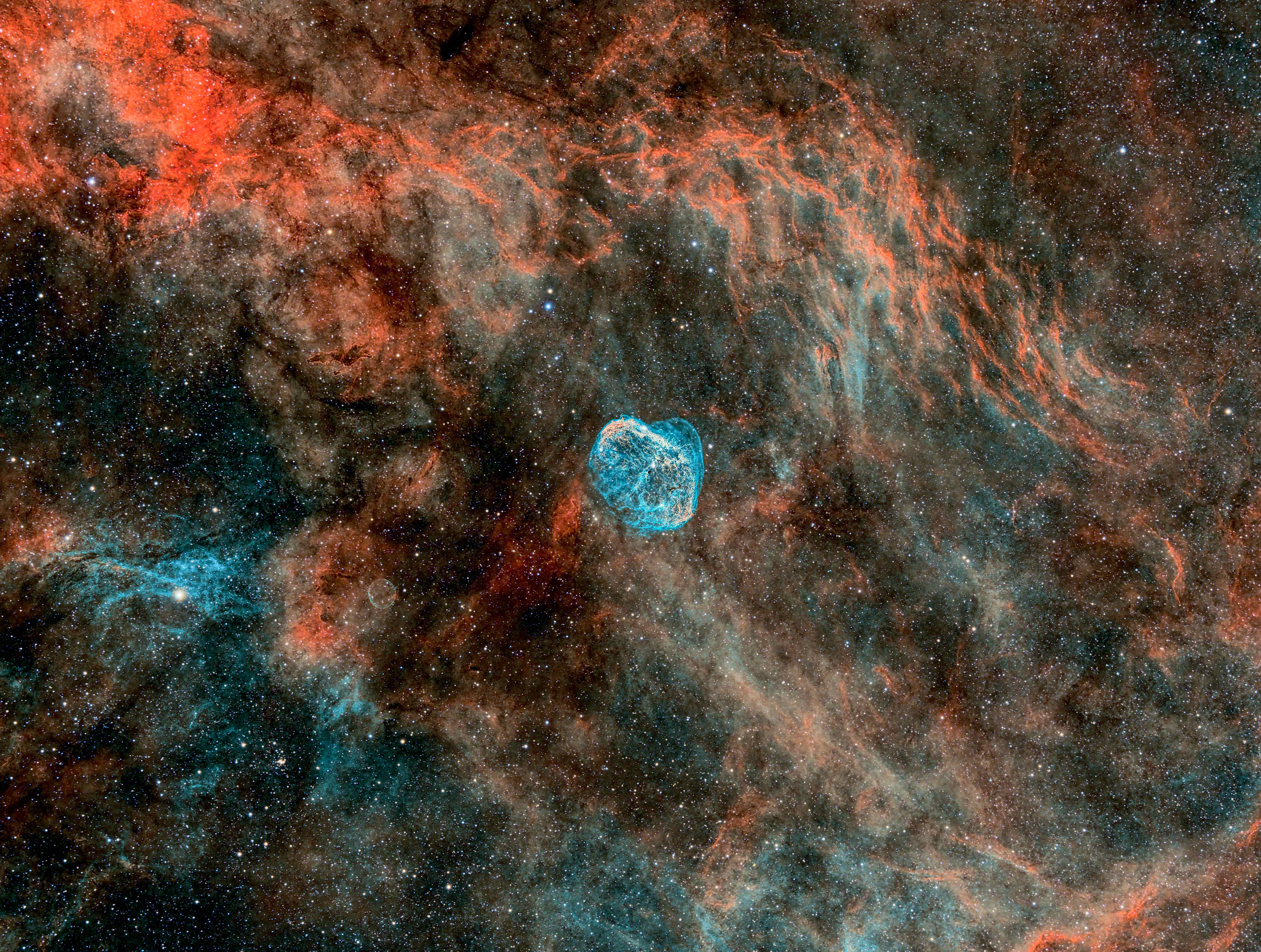 |
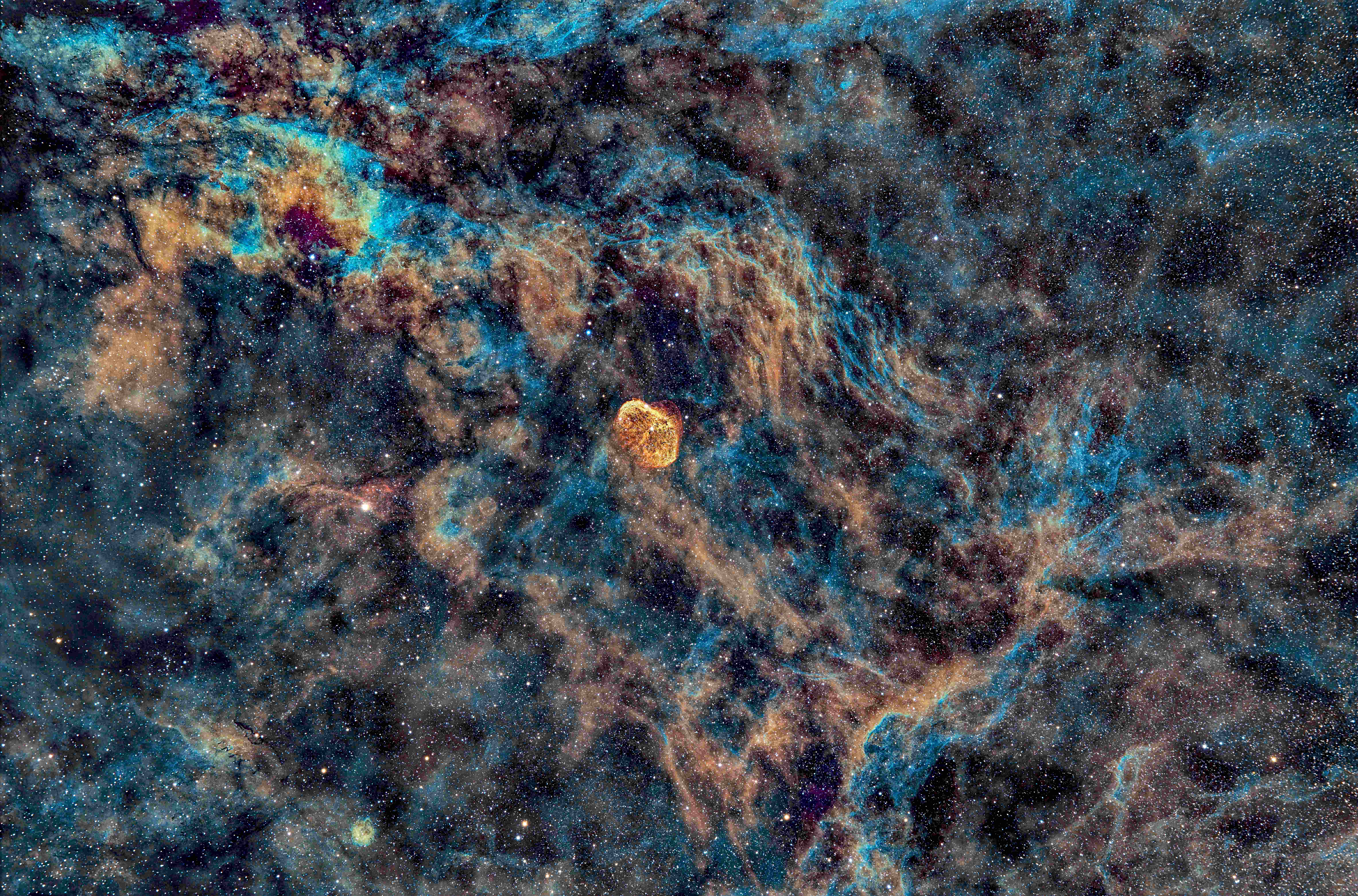 |
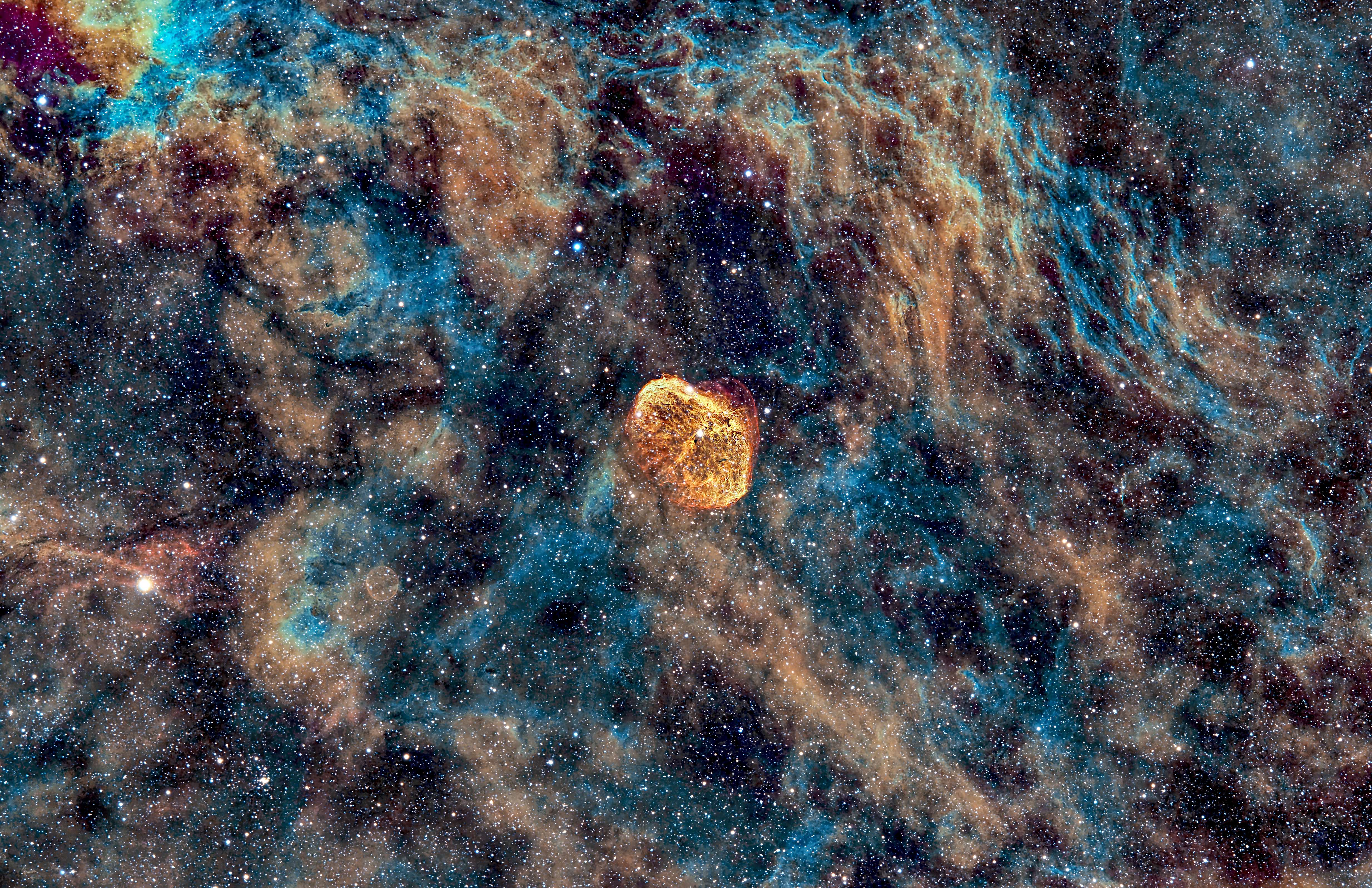 |
| NGC 3324
_The Gabriela Mistral Nebula (HSO) At a distance of 9100 light-years from Earth, in the southern constellation of Carina (the keel of the ship Argo Navis from the story of Jason and the Argonauts), is the Gabriela Mistral Nebula. It was named after the Chilean poet. Carina also holds the second brightest star in out nighttime sky, Canopus. The nebula is about 12 million years old. Image processed by Ron Yelton, original data from Telescope Live |
RCW 49 - The
Whirling Dervish Nebula (OHS) This nebula is located in the constellation Carina and consists of a large cloud of hydrogen gas. It lies about 13,700 light-years away and is between 300-400 light-years across. Also known as the Whirling Dervish Nebula it contains about 2200 new stars, making it an active star making factory. Image processed by Ron Yelton, original data from Telescope Live |
RCW 100 - The
Fine Ring Nebula This unusual planetary nebula is in the very small southern constellation of Norma (the Latin word for a carpenter's square, ruler or level). it's about 2500 light-years away from us. What makes it unusual is that it was formed from a star that was part of a binary system. Most planetary nebulae are either spherical, elliptical or bi-polar (displaying two symmetric lobes). This binary pair are almost face-on to us and have an orbital time of 2.9 days. Image processed by Ron Yelton, original data from Telescope Live |
|
Location:
El Sauce Observatory,
Chile
Date: April 2025 Mount: Mathis MI-1000/1250 Telescope: Planewave CDK24 (CHI-1) Camera:QHY600m @-25c (CMOS) Exposure: 47 x 5 min for HSO. Total: 3 hrs 55 min |
Location: El Sauce
Observatory, Chile
Date: April 2025 Mount: Mathis MI-1000/1250 Telescope: Planewave CDK24 (CHI-1) Camera:QHY600m @-25c (CMOS) Exposure: 81 x 5 min for OHS. Total: 6 hrs 45 min |
Location: El Sauce
Observatory, Chile
Date: April 2025 Mount: Mathis MI-1000/1250 Telescope: Planewave CDK24 (CHI-1) Camera:QHY600m @-25c (CMOS) Exposure: 90 x 5 min for OHS. Total: 7 hrs 30 min |
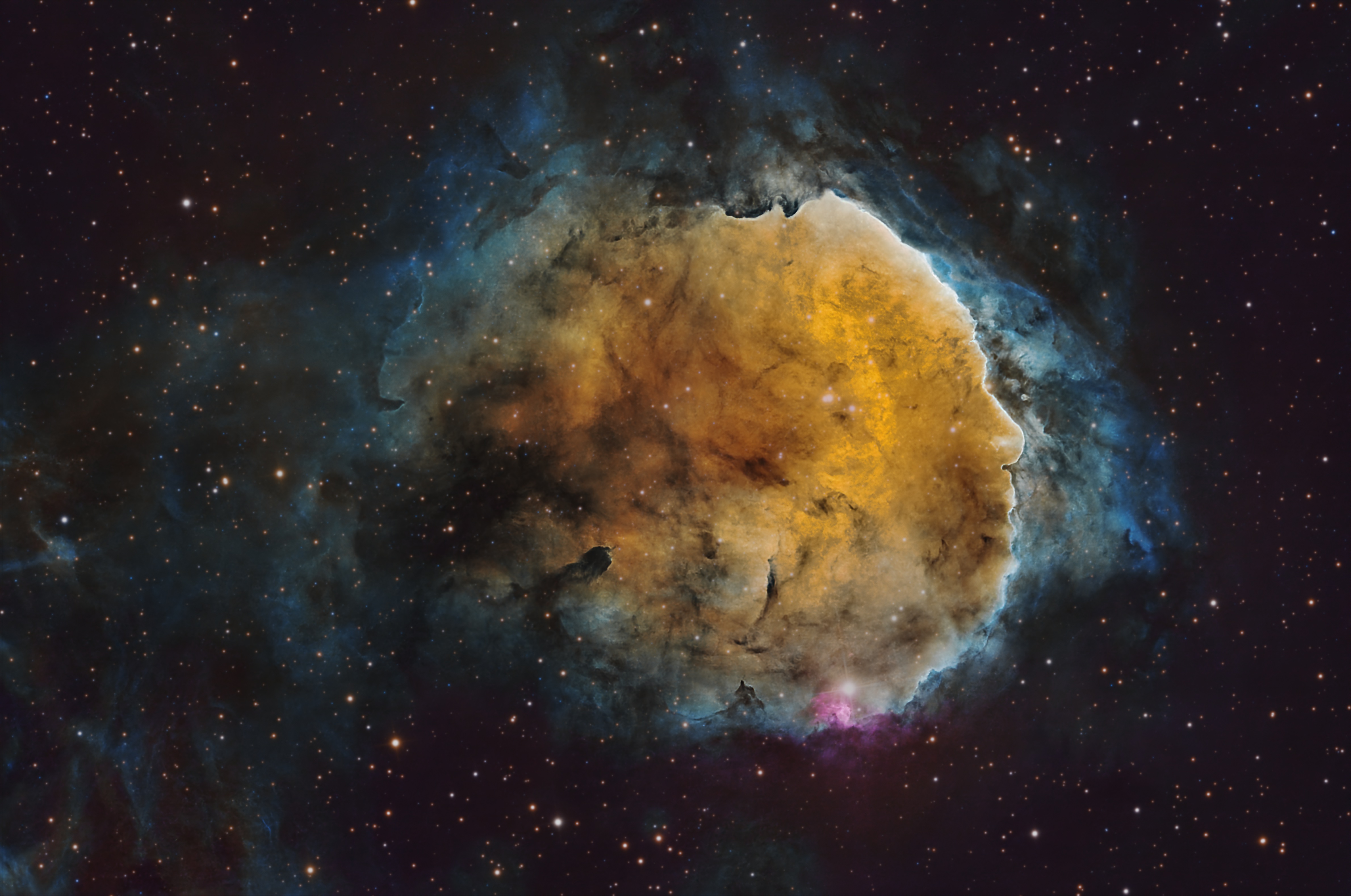 |
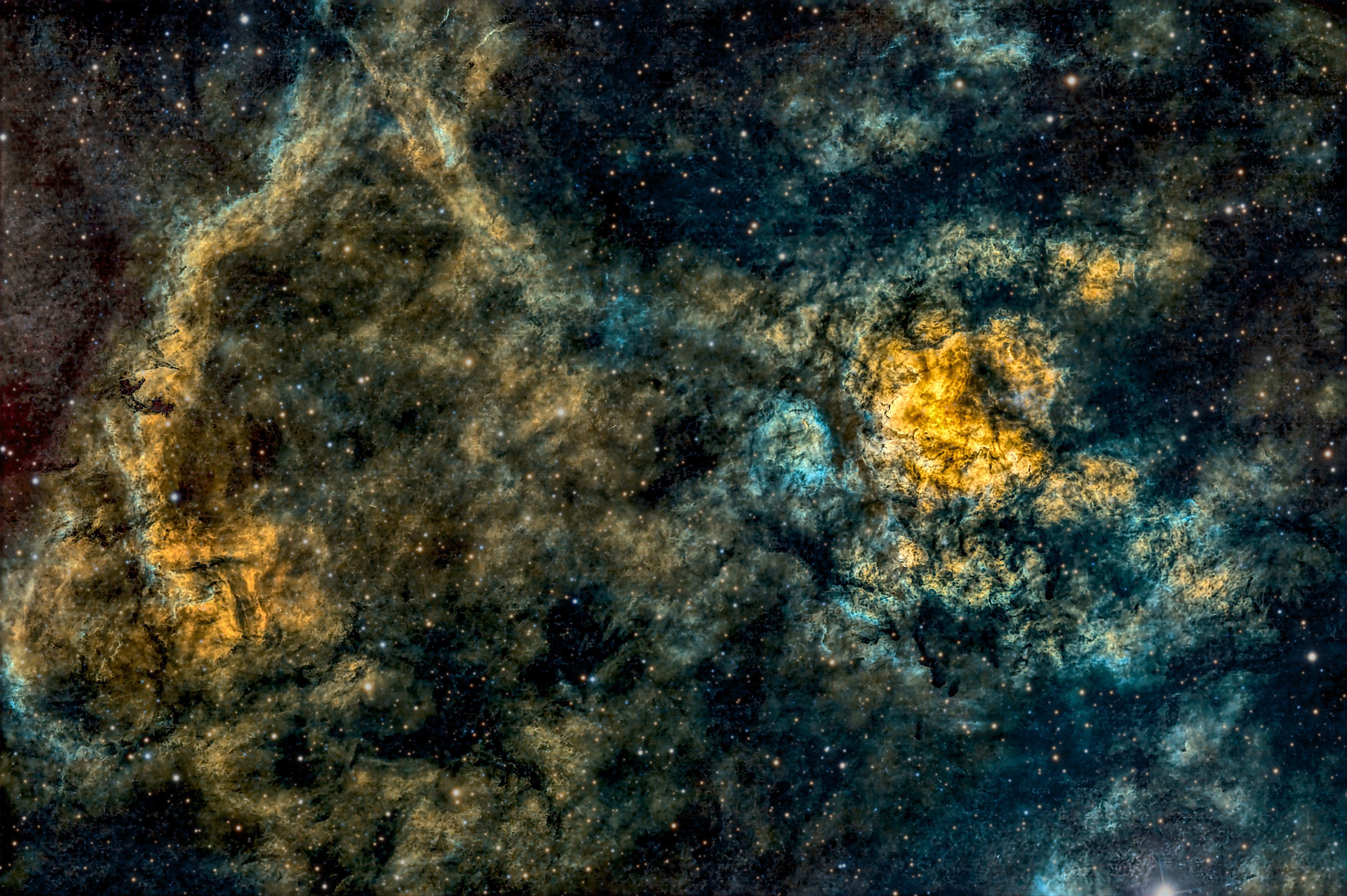 |
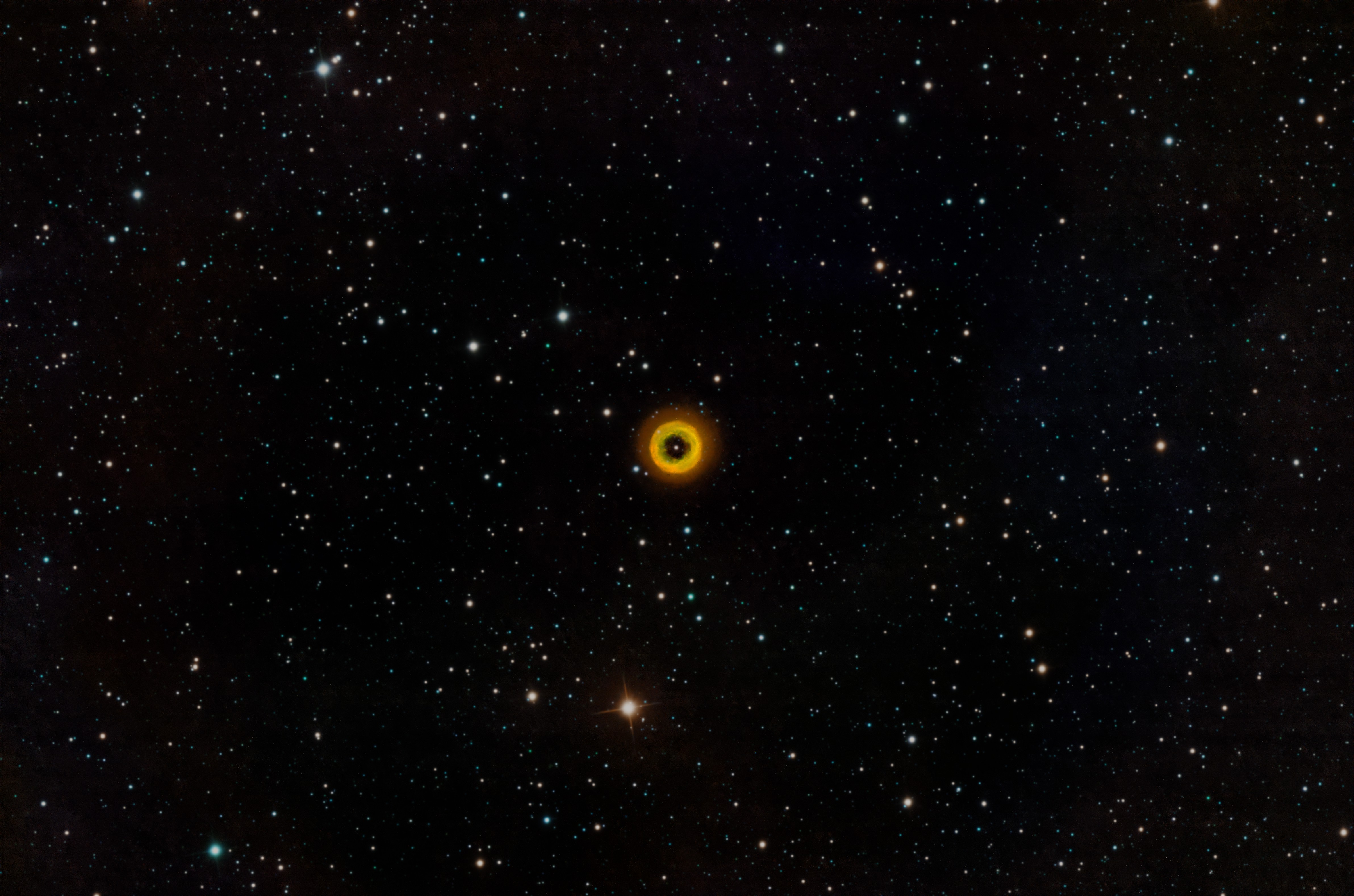 |
| NGC
6302 - The Bug Nebula This is a bipolar planetary nebula located in the constellation Scorpius. Scientists are still unsure as to why a star would end its life in this fashion as opposed to the more common spherical planetary nebula. the surface of this white dwarf is around 250,000 degrees Celsius, which makes it one of the hottest bodies known to us. This particular image is new rendering of the ones on the Nebula 5 page. Image processed by Ron Yelton, original data from Telescope Live |
RCW
19 (GUM 10) This is an emission nebula in the southern constellation of Puppis. It is part of an enormous molecular cloud complex and sits about 10,760 light-years away. There is a lot of active star formation in its interior. Image processed by Ron Yelton, original data from Telescope Live |
RCW 19
(GUM 10) This is a different view of the object to the left. That one was processed with the HSO palette. This one is done with the OHS palette. Image processed by Ron Yelton, original data from Telescope Live |
|
Location: El Sauce
Observatory, Chile
Date: August 2024 Mount: Mathis MI-1000/1250 Telescope: Planewave CDK24 (CHI-1) Camera:QHY600m @-25c (CMOS) Exposure: 85 x 5 min for OHS. Total: 7 hrs 5 min |
Location:
Heaven's Mirror Observatory,
Australia
Date: May 2025 Mount: Paramount MX+ Telescope: FSQ-106ED (AUS-2) Camera: QHY600m @ -25c Exposure: 90 x 5 min each for HSO Total: 7 hrs 30 min |
Location:
Heaven's Mirror Observatory,
Australia
Date: May 2025 Mount: Paramount MX+ Telescope: FSQ-106ED (AUS-2) Camera: QHY600m @ -25c Exposure: 90 x 5 min each for OHS Total: 7 hrs 30 min |
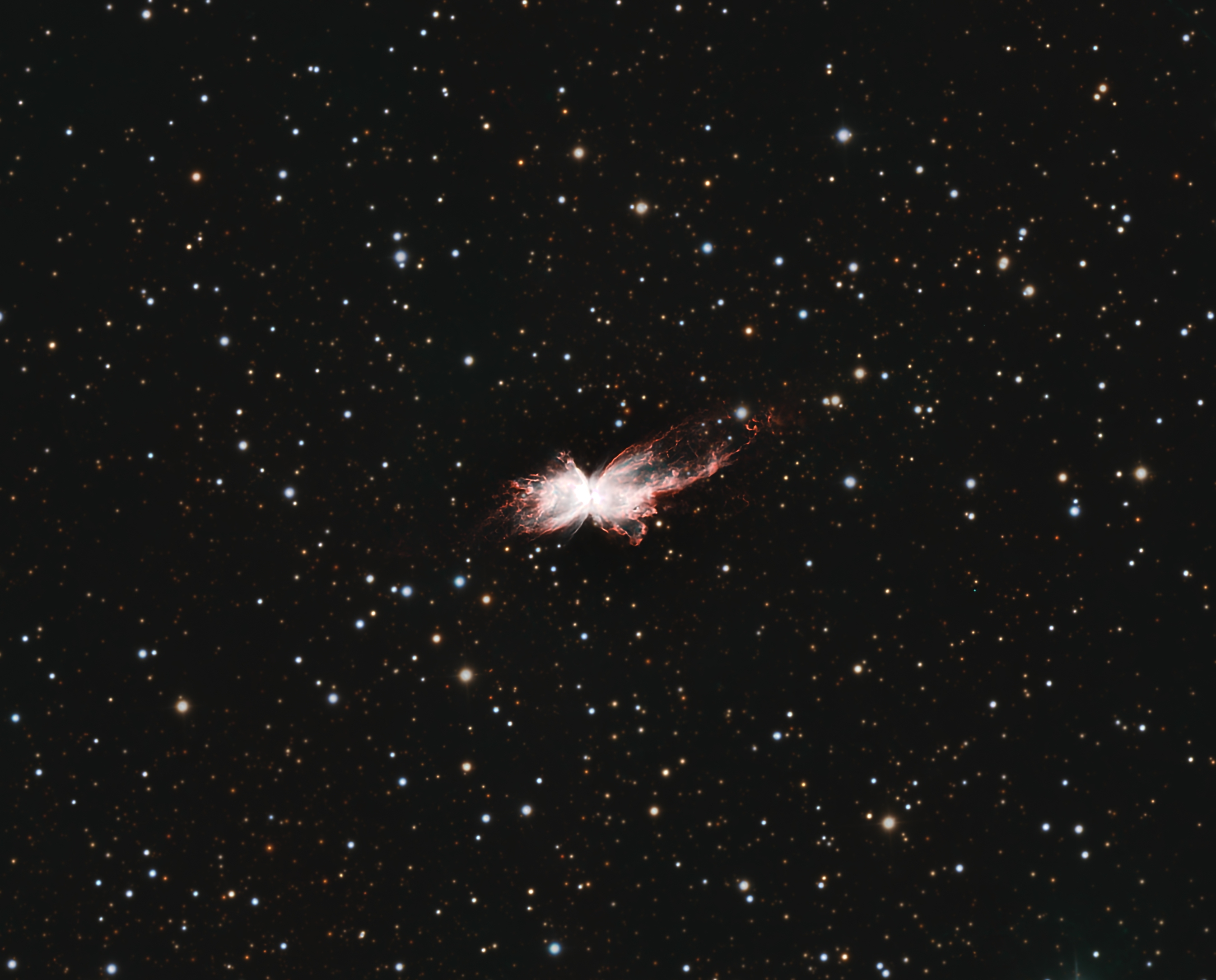 |
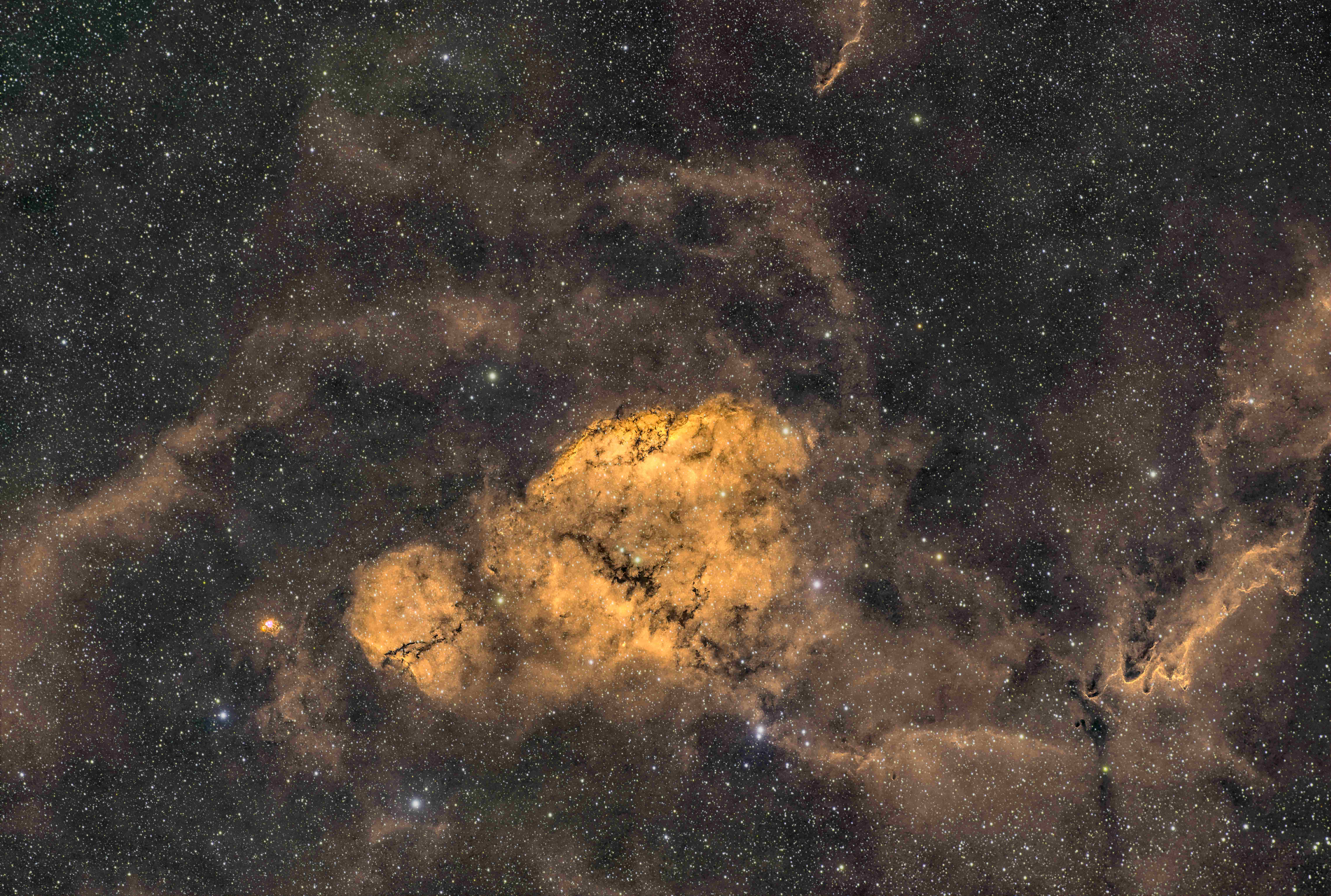 |
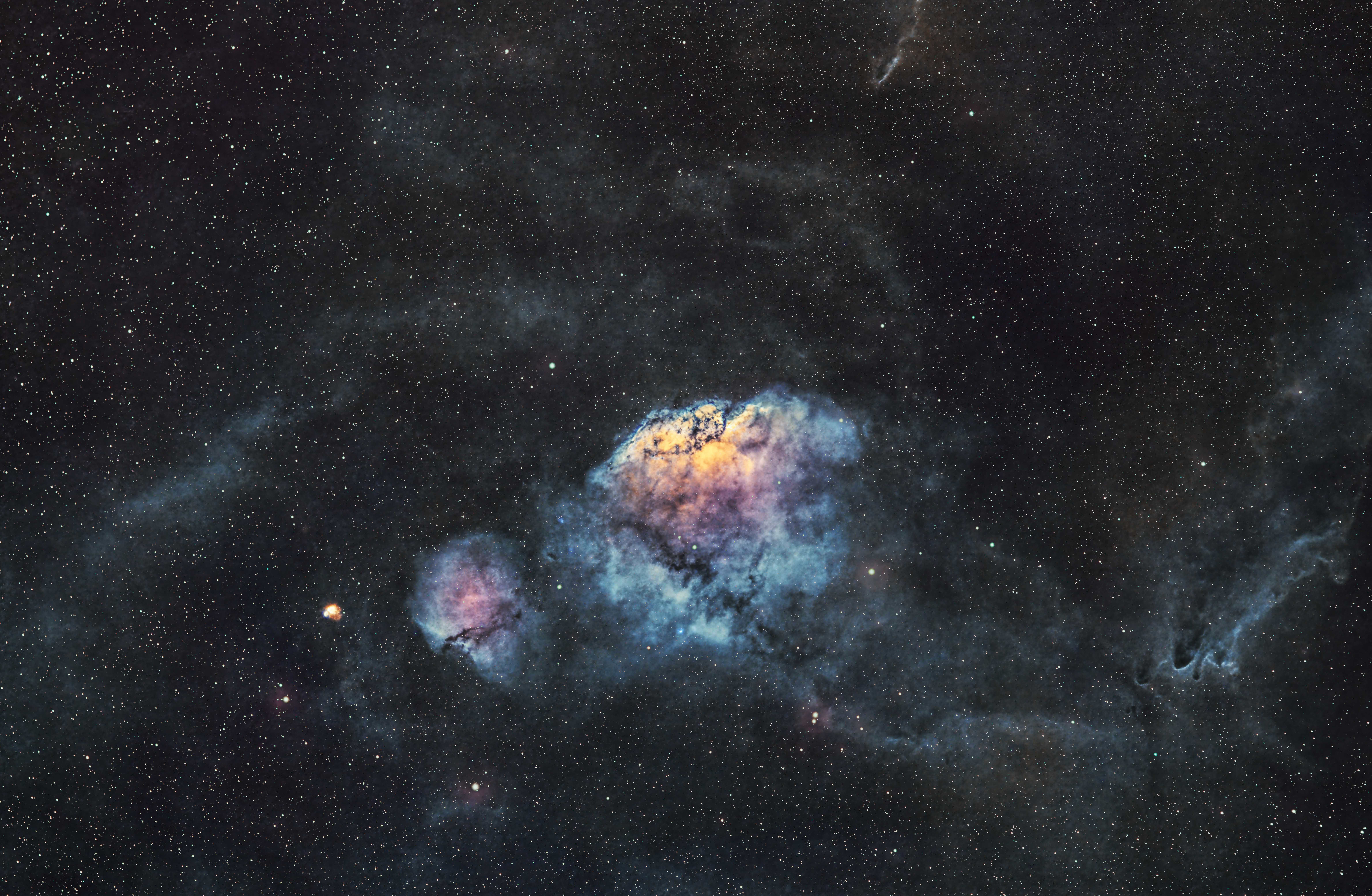 |
| NGC
3324 Buried in the heart of the Gabriela Mistral Nebula, is the open cluster NGC 3324. Just down and left of center is a round, orange area. The cluster (difficult to see) is inside this bright area. The surrounding nebula is an emission nebula. Its age is estimated to be around 12 million years. Image processed by Ron Yelton, original data from Telescope Live |
NGC 2264 This nebula is in the constellation Monoceros. It lies about 2700 light-years away from us. NGC 2264 actually refers to two objects The Cone Nebula and the Christmas Tree Nebula. Also within this huge reflection nebula are the Fox Fur and Snowflake Nebulae. I did a real-time processing of this object as a presentation for our local astronomy club in April 2024. I processed it at least once a day for a month in order to recreate the first version. Never could duplicate that first effort, but this one turned out just as nice. I've done this image a number of times all with different telescopes and cameras Image processed by Ron Yelton, original data from Telescope Live |
LDN 1667 This dark nebula is part of the greater Orion Molecular Cloud Complex. It sits about 600 light-years away from us. Image processed by Ron Yelton, original data from Telescope Live |
|
Location:
Heaven's Mirror Observatory,
Australia
Date: May 2025 Mount: Paramount MX+ Telescope: FSQ-106ED (AUS-2) Camera: QHY600m @ -25c Exposure: 90 x 5 min each for HSO Total: 7 hrs 30 min |
Location: IC Astronomy Observatory, Spain
Date: February 2023 Mount: Paramount MX+ Telescope: Takahashi FSQ-106ED (SPA-1) Camera: QHY600m CMOS @ -25c Exposure: 62 x 5 min for HSO Total: 5 hrs 10 min |
Location: Heaven's Mirror Observatory, Australia Date: December 2022 Mount: Paramount MX+ Telescope: FSQ-106ED (AUS-2) Camera: FLI PL16083 @ -25c Exposure: 50 x 10 min each for Ha, OIII and SII. Total:8 hr 20 min. |
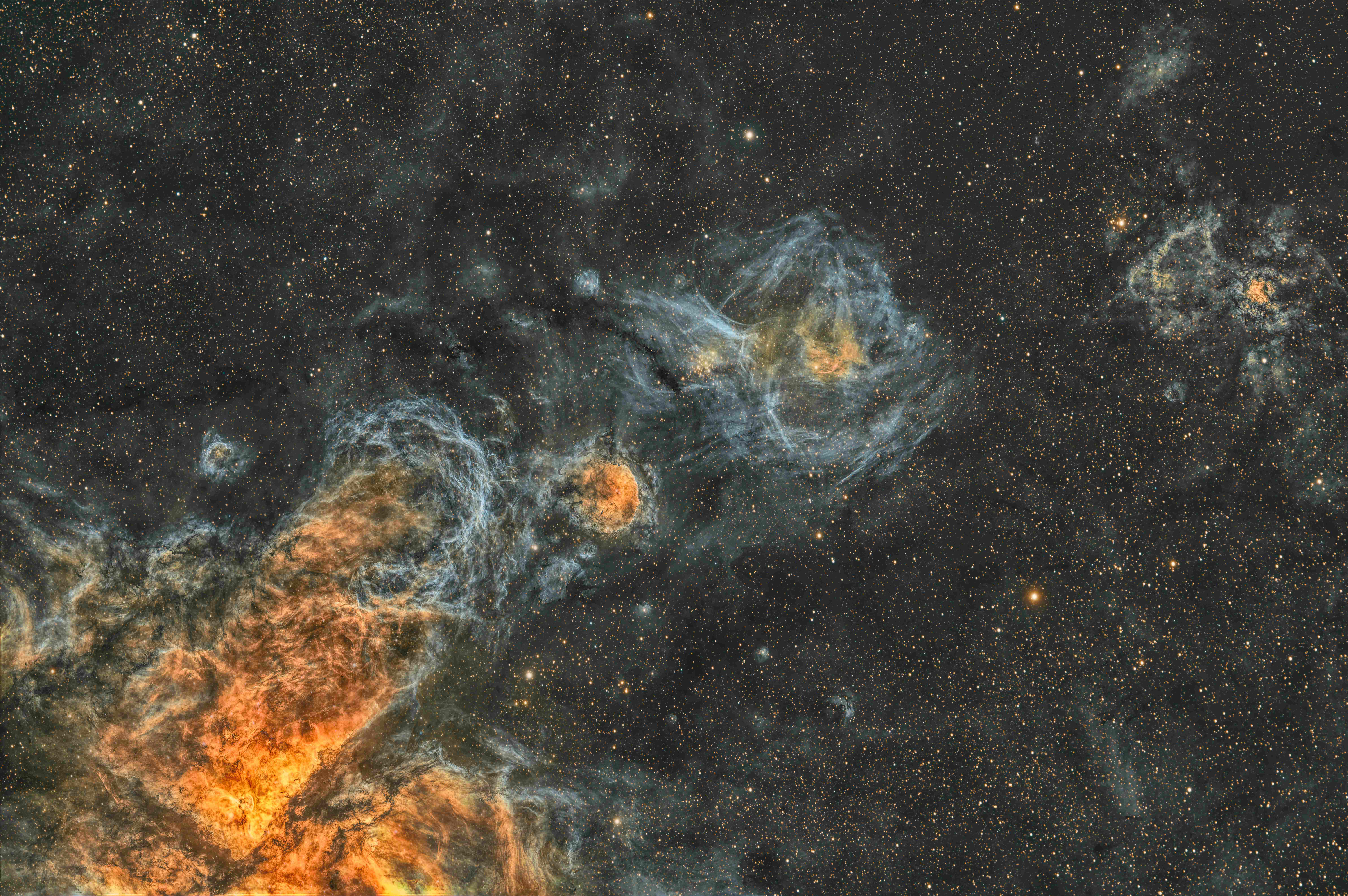 |
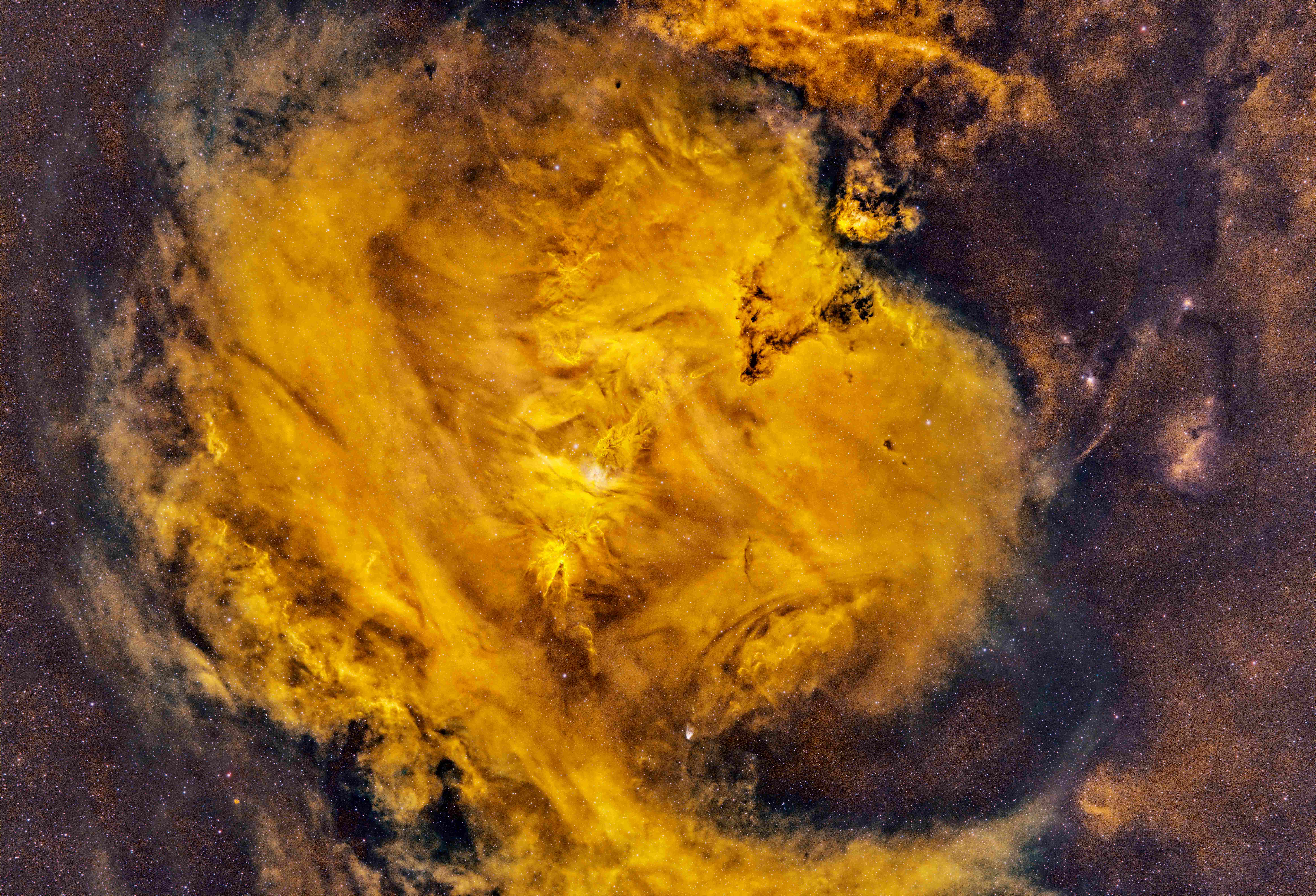 |
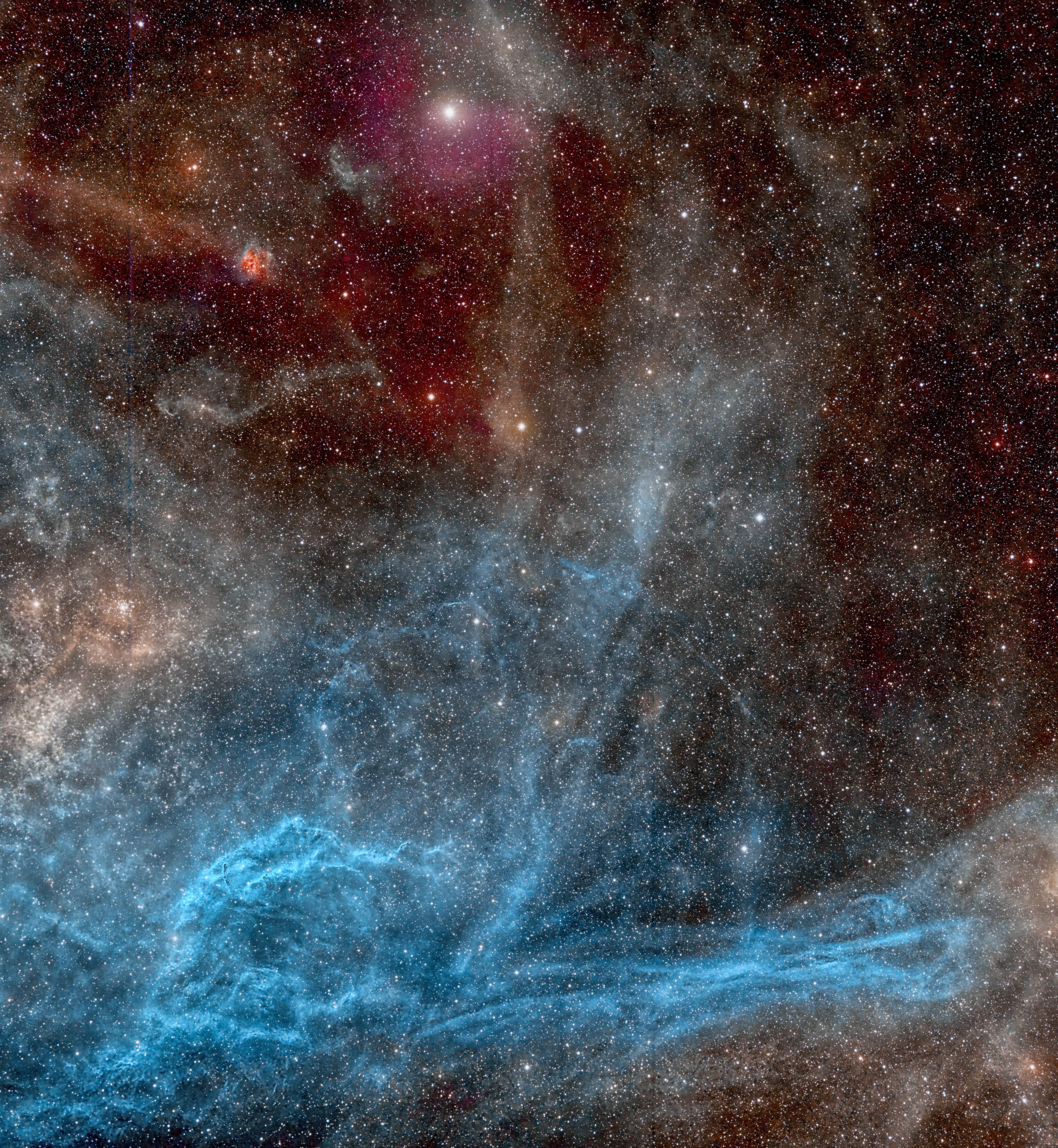 |
| NGC
281 A bright emission nebula resides in the northern part of the constellation Cassiopeia. It is also known as the Pac Man Nebula and sits about 9500 light-years away. Image processed by Ron Yelton, original data from Telescope Live |
CTB 1
(Abell 85) - The Medula Nebula About 10,000 yrs ago a massive star exploded in the constellation Cassiopeia. What remained afterward, was this supernova remnant and a high-velocity pulsar at its center. The outer, expanding shell is a rich radio and x-ray source. It sits just shy of 10,000 light-years away from us and has a diameter of about 98 light-years. Its very low surface brightness makes it a difficult object to image. It is also known as the Garlic Nebula. If you look closely at the shell's 4 o'clock position. there is an interesting "small" cloud of dark nebulosity. Image processed by Ron Yelton, original data from Telescope Live |
iC 443
- The Jellyfish Nebula tC 443 also known as the Jellyfish Nebula and Sh3-248 is a galactic supernova remnant (SNR) in the constellation Gemini. It is located near the star Eta Geminorum. Its distance is roughly 5,000 light years from Earth. IC 443 may be the remains of a supernova that occurred 3,000 - 30,000 years ago. The same supernova event likely created its neutron star, the collapsed remnant of the stellar core. IC 443 is one of the best studied cases of supernova remnants interacting with its surrounding molecular clouds. This image has almost 50 hours of exposure an was taken with a telescope with a wider field of view than my original image on the Nebula-2 page. It was taken with both Hydrogen and Oxygen filters. Image processed by Ron Yelton, original data from Telescope Live |
|
Location: IC Astronomy Observatory,
Spain
Date: August 2023 Mount: Officina Stellare EQ Mount Telescope: Officina Stellare Pro RC 700 (27" f/8) (SPA-2) Camera: FLI PL16803 23' x 23' @-25c Exposure: 129 x 10 min each SHO Total: 4 hrs 20 min |
Location: Italy
Date: July 2025 Mount: Unknown Telescope: ASA N10 250 FL 900mm F/3.6 (T-23) Camera: Player One Mono 571 Exposure: 511 x 10 min each (HOO)HaO Total: 17hrs 25min |
Location: Italy
Date: December 2025 Mount: Unknown Telescope: ASA N10 250 FL 900mm F/3.6 (T-23) Camera: Player One Mono 571 Exposure: 258 x 10 min each (HOO)HaO Total: 42hrs 40min |
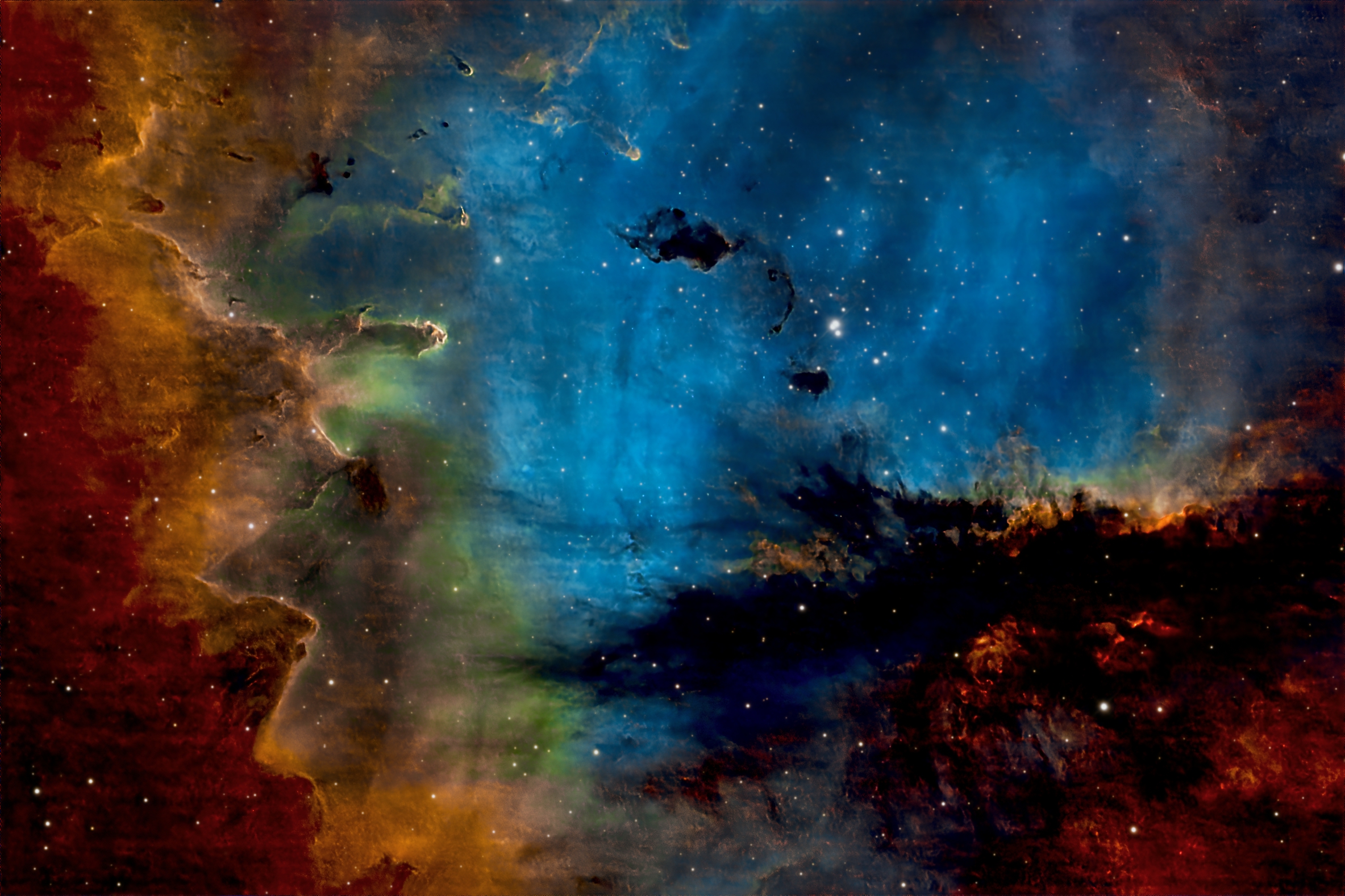 |
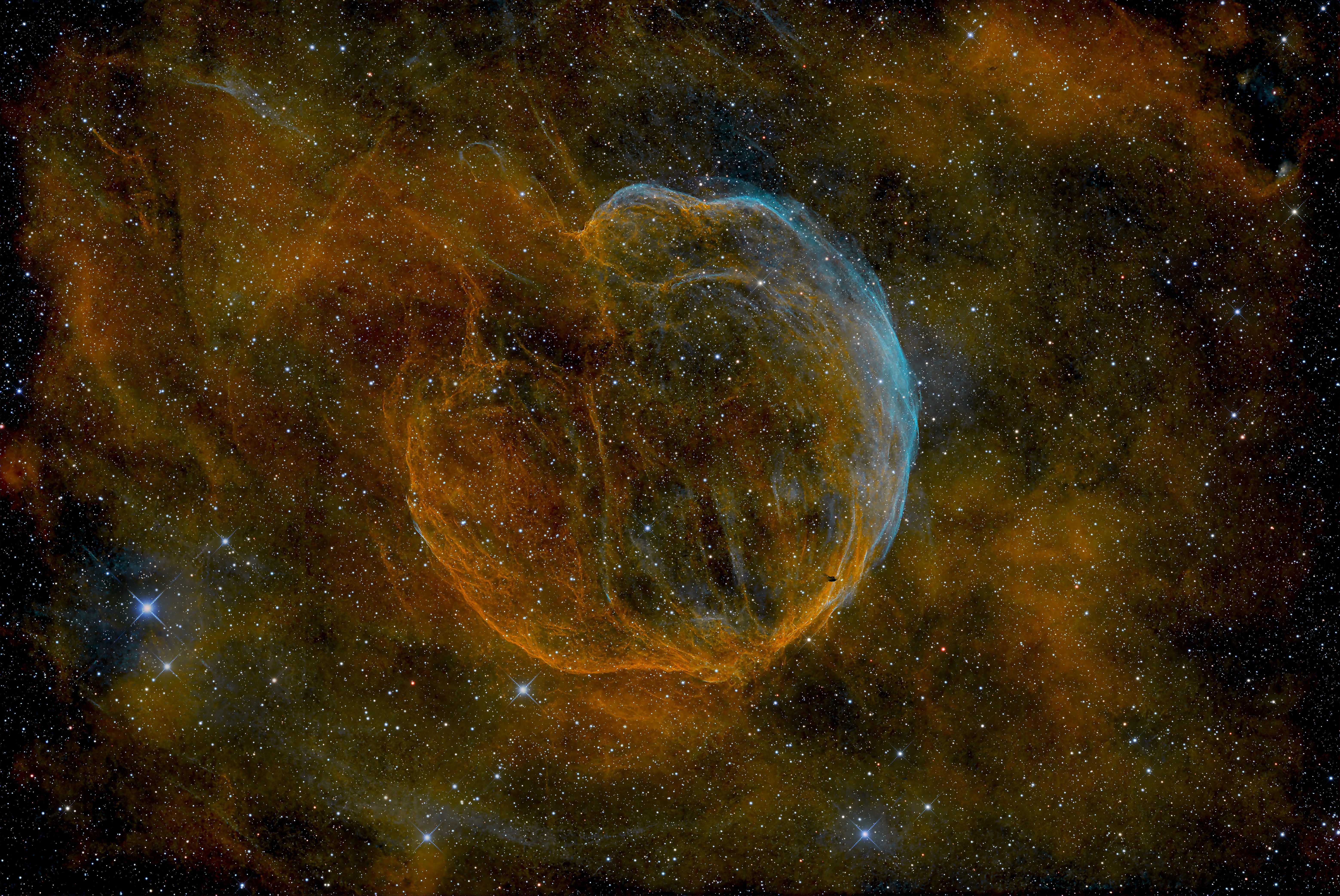 |
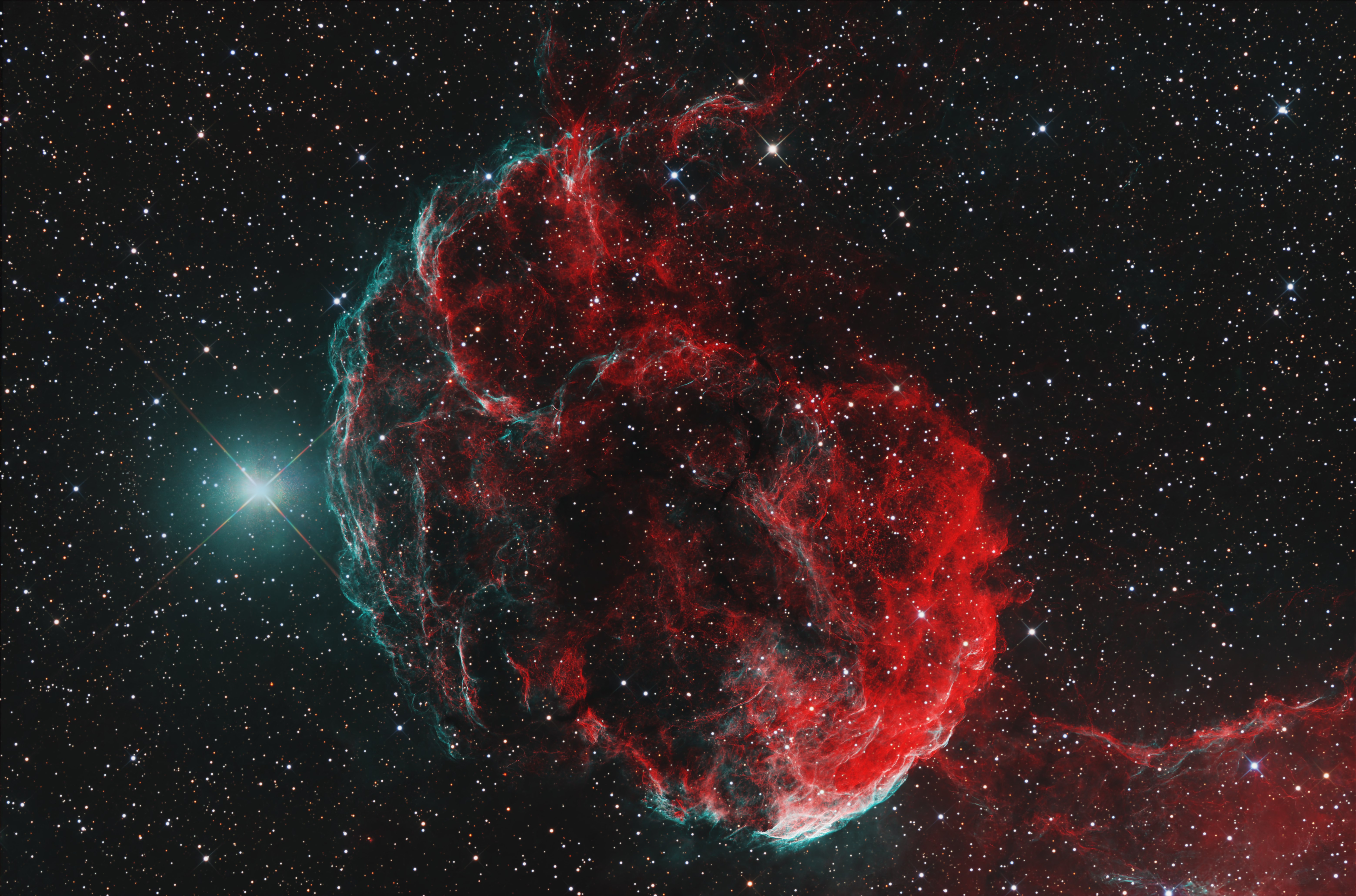 |
Except as noted all images Copyright © by Ron Yelton and may not be used without permission.